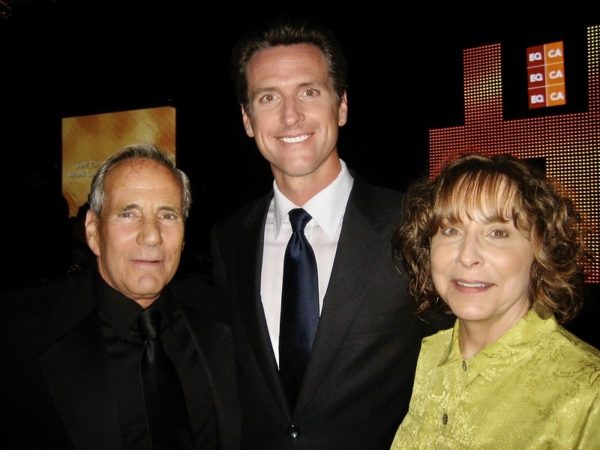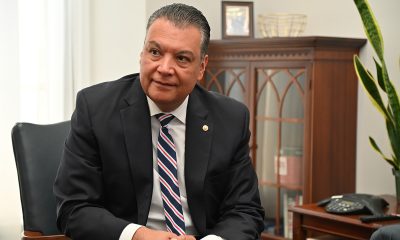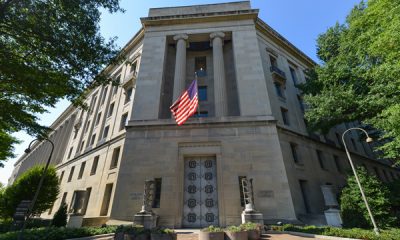History
Phyllis Lyon gives a happy middle finger to the Lavender Scare
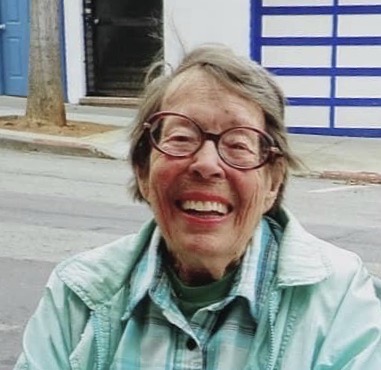
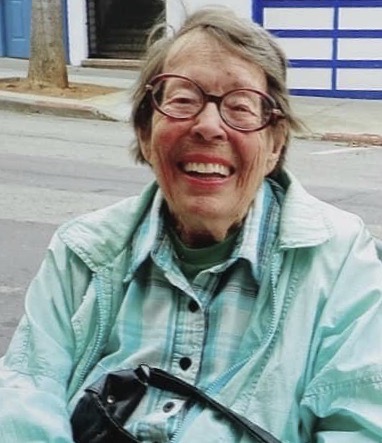
Phyllis Lyon (Photo courtesy Kate Kendell)
“Phyllis Lyon is not afraid of the L-word, whether it be lesbian or liberal – or even lipstick. In fact, L-words best describe her life,” writes Del Martin, Lyon’s partner of 58 years, in their friend Vern L. Bullough’s 2002 book,“ Before Stonewall: Activists for Gay and Lesbian Rights in Historical Context.”
“‘I am a single Lyon,’ she protests when people persist in adding an ‘s’ to her name,” Martin continues. “She has the largess, pride, and roar of a lion. She is distinguished by her laughter. She loves light and bare windows. She is loquacious, but she also listens. She is loving, loyal, learned, logical. She loves literature and she is an avid reader. She is a lover, a leader, a liaison. She lives up to her ideals. She also likes to live it up. Her concerns are limitless, as are her talents. She hopes to win the lottery so she can support all her causes more lavishly,”
Del Martin died on Aug. 27, 2008, ten weeks after she and Phyllis Lyon made headlines and history as the iconic lesbian couple legally married by San Francisco Mayor Gavin Newsom on June 16, 2008. Lyon was at Martin’s side when she died at age 87.
Lyon died of natural causes on April 9 at their hilltop home in San Francisco, surrounded by loving friends. She was 95.
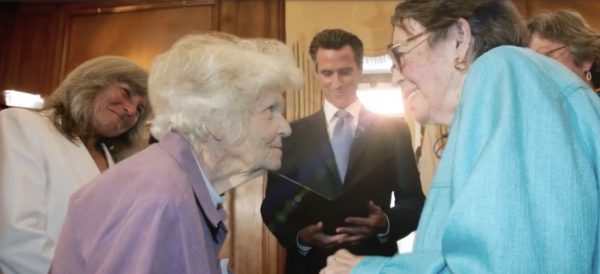
Now-California Gov. Gavin Newsom, who had become personally close with Lyon over the years, broke from his daily coronavirus briefing to commemorate the passing of his friend and hero. He featured their wedding when he announced his run for governor and a video clip still plays at the top of his Facebook page.
“I had the privilege of being involved in a marriage ceremony between Phyllis Lyon and Del Martin,” Newsom told the Los Angeles Blade during the live-streamed news conference watched by more than 9.5 thousand people. “The couple had been together for almost a half a century – the manifestation of faith, love and devotion, and yet they were denied on the basis of their sexual orientation the right to say two extraordinary words: ‘I do.’ The power and potency of those two words is profoundly significant.”
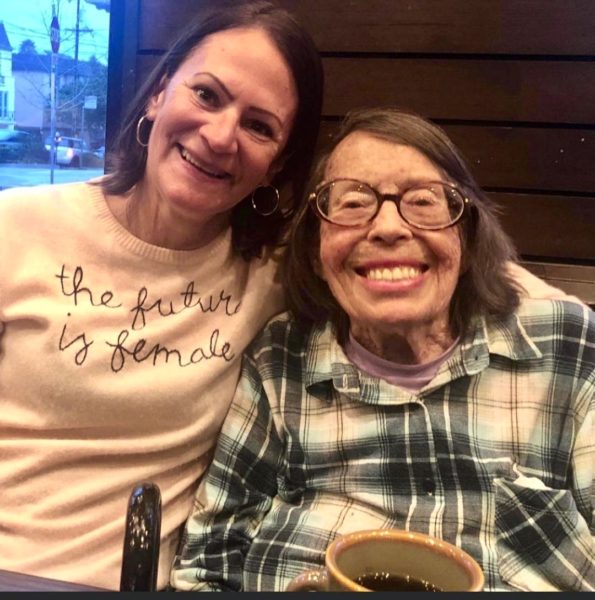
Joyce Newstat with Phyllis Lyon (Photo courtesy Newstat)
Del Martin and Phyllis Lyon were unquestionably the couple to be the “face” of marriage equality, says Joyce Newstat, Policy Director for then-Mayor Newsom who helped plan that first history-making marriage on Valentine’s Day 2004, their 51st anniversary, after which 4,000 other couples lined up around City Hall seeking marriage licenses.
“We were already standing on their shoulders and now this would be yet another act of courage on their part,” Newstat tells the Los Angeles Blade. “We knew that they also would be symbolic of love enduring between two people — and that was to be the face of marriage equality. How would you be scared or how could you possibly be so vehemently against these two lovely wonderful, powerful women who’d been together for 50 years being able to declare their love for each other in front of family and friends and then the world and having the same legal rights as other couples, men and women?”
But what does “standing on their shoulders” actually mean?
Most of the tributes to lesbian icon Phyllis Lyon focus on her historic symbolic (2004) and legal (2008) marriages to Del Martin. But in fact, their lives are even more profound, having both resisted the Lavender Scare and forged a new definition of equality in defiance of inculcated gender and societal stereotypes. They were pioneers of self-acceptance.
Phyllis Ann Lyon was born to a Republican traveling salesman and a Southern Democrat homemaker on Nov.10, 1924 in Tulsa, Oklahoma just before the Great Depression. The family moved to Northern California in the early 1940s. Lyon graduated from Sacramento Senior High School in 1943 during the paranoia of World War II nearby. For three months in 1942, the Pinedale Assembly Center located just north of Fresno served as a Japanese internment camp for 4,823 people.
Lyon attended the University of California/Berkeley where she served as a reporter and editor for the student newspaper, the Daily Californian, and wrote a scathing editorial about the internment camps, Martin reported in Before Stonewall.
Lyon graduated in 1946 with a BA in Journalism, emerging into an America struggling to return to pre-war society but pulsing with young people enthralled with freedom.
World War II especially liberated women who were recruited — most notably through the Rosie the Riveter campaign — to join the war effort and take up jobs in the wide-ranging defense industry. By war’s end in 1945, one out of every four married women worked outside the home; more than seven million women had joined eleven million other women who were already in the work force.
Their mass firing with new patriotic orders to return home to serve their husbands or become “pretty little things” whose sole job was to look for a husband created a subterranean rancor to the reactionary Cold War conformity. Freudian psychiatry experienced a boom. “Freud gave Victorian antifeminism the appearance of scientific standing. His theory of penis envy not only took for granted the inferiority of women but provided an ideological rationalization of it. Psychoanalysis thus reinforces the dependence and subordination of women,” some feminists said later
This was the climate in which young journalist Phyllis Lyon sought a job. “I was determined I was not going to be a society writer,” Lyon told David Mixner and Dennis Bailey for Brave Journeys: Profile in Gay and Lesbian Courage. She relented after a corporate job led to abject boredom. Fortuitously, that position was taken at The Chico Enterprise and she gladly accepted the position of general reporter. She covered the police beat and city hall, competitively trying to out-scoop her rivals at The Chico-Record. She also covered stories “on rural Chico’s underbelly” – bar brawls and domestic quarrels.
One assignment was particularly meaningful — interviewing former First Lady Eleanor Roosevelt at a train “whistle stop” in the nearby town of Durham. After the death of her husband, President Franklin Delano Roosevelt, President Harry Truman appointed her as a delegate to the United Nations General Assembly in Dec. 1945. She soon became the first chairperson of the UN Commission on Human Rights, where she later led the drafting of the Universal Declaration of Human Rights.
Eleanor Roosevelt was “the most wonderful woman I had ever heard of,” Lyon told Dianna Lee Johnson in Nov. 2010 for the scholar’s Masters Theses. “Women didn’t do a lot of things like she did in those days.”
When Roosevelt stepped off the train, Lyon froze.
“I should have begun to ask her questions if it hadn’t been that she was my absolute heroine and I was so excited about getting to even meet her that I didn’t realize what was going to happen when I did. And I just froze.” The staff photographer got a shot of Lyon’s back as Roosevelt smiled down on her.
“Graciously, Mrs. Roosevelt conducted the interview herself,” Martin wrote. It was a story Lyon told often, laughing at her big rookie mistake.
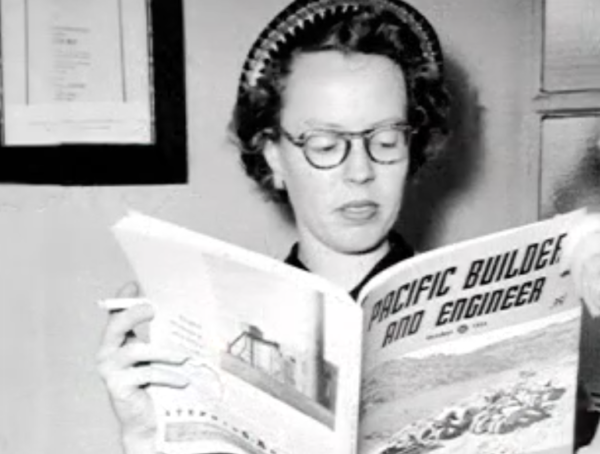
Phyllis Lyon (screen grab from “No Secret Anymore)
Chico was too small after Eleanor Roosevelt and in 1949 Lyon moved to Seattle, first writing “man on the street” articles for a naval outlet then getting an editorial staff position at two building trades magazines published by Pacific Builder and Engineer. Unaware of her sexuality, Lyon dated married men, reflecting to Mixner and Bailey later that “it was safer.” At one point she was engaged to an older single man, but broke it off over his “penchant for jealousy.”
And then Lyon met Martin, a “gay divorcee” who had moved to Seattle from San Francisco to serve as editor of Daily Construction Reports, owned by the same publisher.
Lyon was mesmerized. “She had on pumps and then a little green gaberdine suit and she was carrying a briefcase. And never before had I seen a woman carrying a briefcase,” Lyon tells JEB (Joan E. Biren) for her documentary “No Secret Anymore: The Times of Del Martin & Phyllis Lyon. “I had a party at my apartment for her and invited all the folks from work. She spent most of her time in the kitchen with the guys who were trying to teach her how to tie a tie and smoking cigars. She said I was her good, straight friend. But she always accused me of flirting with her, too.”
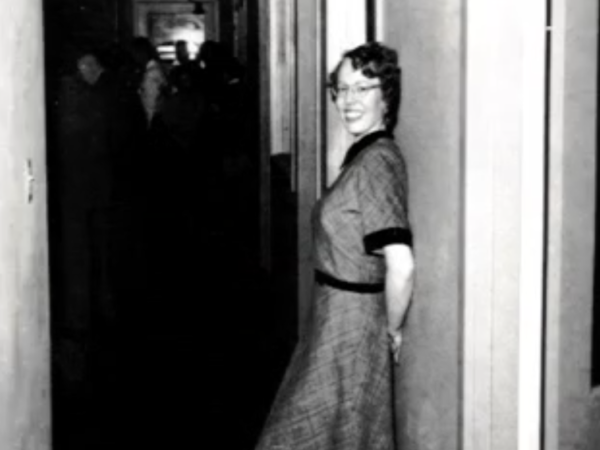
“You flirted with everybody,” says Martin.
“Well, she made sort of a half-a-pass at me and I made a pass back so we kind of got together in bed. But we didn’t make any commitment. So, I quit the job and got back to the Bay Area. I was writing letters to her and she was writing back and about the time she decided it was hopeless, I wrote and said she should come down. And that was in 1953. She came down on Valentine’s Day. Got in about 11:00 at night but it was still Valentine’s Day,” says Lyon.
“That way you can’t forget your anniversary,” says Martin.
Martin had already discovered that she was a lesbian by reading The Well of Loneliness, though subsequent research into library books revealed the prevalent label for those feelings were “sick” and “perverted,” with no cure except lobotomy or forced behavioral conversion therapy. But when Martin shared her secret with Lyon and co-workers during a discussion about homosexuality, Lyon was so impressed, she called all their friends. She had no idea that outing Martin was dangerous.
“[A]fter the war a concern began to grow throughout the nation that American morality was in a state of decline. Publication of the Kinsey report fed these fears, particularly Kinsey’s statistics that suggested widespread homosexual behavior,” David K. Johnson, author of The Lavender Scare: The Cold War Persecution of Gays and Lesbians in the Federal Government, said in a 2004 interview with the University of Chicago press.
Congress was on high alert as Sen. Joseph McCarthy’s House on Un-American Activities Committee (HUAC) hearings charged that communists and homosexuals had infiltrated the federal government to undermine the nation’s morality and security.
“The Lavender Scare helped fan the flames of the Red Scare. In popular discourse, communists and homosexuals were often conflated. Both groups were perceived as hidden subcultures with their own meeting places, literature, cultural codes, and bonds of loyalty. Both groups were thought to recruit to their ranks the psychologically weak or disturbed. And both groups were considered immoral and godless. Many people believed that the two groups were working together to undermine the government.”
A true understanding of the dangerous and harmful Red Scare requires also an equal understanding of the Lavender Scare, Johnson argued.
“A survey of McCarthy’s mail suggests that his supporters were more concerned about allegations that the federal government was harboring sexual deviants than they were about political deviants. President Truman’s aides also thought the homosexuals-in-government issue posed a more dangerous political weapon than the communists-in-government issue,” he said.
McCarthy, whose chief aide was unscrupulous closeted attorney Roy Cohen, seemed focused on the power he derived from thundering about threats of communist infiltration. So ferreting out homosexuals fell to Senators Styles Bridges and Kenneth Wherry.
Their rationale, Johnson said, “wasn’t that homosexuals were communists but that they could be used by communists.” But after months of investigation, they found “no evidence that even a single gay or lesbian American civil servant had ever been blackmailed into revealing state secrets.”
Nonetheless, their final report “emphatically” stated that “homosexuals posed a threat to national security,” said Johnson. Meanwhile tabloids reported that “communists promoted ‘sex perversion’ among American youth as a way to weaken the country and clear the path for a communist takeover.” Homosexuals “acted as a fifth column, by preventing family formation and fostering moral decay.”
The number of gays and lesbians whose lives were ruined from 1947 to 1954 during the Red Scare and the Lavender Scare may never be known,” said Johnson. “As the nation’s largest employer, the federal government set the tone for employment practices in many industries, and its anti-gay policies were widely copied by the private sector.”
Brad Sears, Nan Hunter and Christy Mallory concurred in 2017 in Documenting Discrimination on the Basis of Sexual Orientation and Gender Identity in State Employment published by The Williams Institute at UCLA School of Law.
“To identify homosexuals in public employment, the FBI sought out state and local police officers to supply arrest records on morals charges, regardless of whether there were convictions; data on gay bars; lists of other places frequented by homosexuals; and press articles on the largely subterranean gay world. Even friendship with a known homosexual subjected individuals to investigation,” the scholars wrote. “[A]nti-homosexual policies had spread from the federal government to nearly all levels of employment in the United States.”
But there was resistance: Harry Hay founded the Mattachine Society in Los Angeles in 1950; ONE Inc was founded in 1952; and the Daughters of Bilitius was founded in 1955 by Lyon and Martin and six others.
Lyon and Martin didn’t start out wanting to change the world — they just wanted to meet other lesbians.
On Valentine’s Day in 1953, when they moved in together in San Francisco’s working class Castro district, change was in the air. UCLA professor Evelyn Hooker, who received a grant to study the difference between gay and straight men, recruited homophiles from the Mattachine Society. Conducting her research in a small study on her spacious Saltair Avenue estate in Los Angeles, she found no significant difference. Two decades later, that research helped declassify homosexuality as a mental illness in the Diagnostic Statistical Manual of Mental Health Disorders.
At the same time, gay poet and war veteran Lawrence Ferlinghetti opened City Lights Books in North Beach, the nation’s first all-paperback bookstore that helped launch the “Beat Generation” in San Francisco. He featured Greenwich Village gay and bisexual transplants Allen Ginsberg, William S. Burroughs, Neal Cassady and Charles Bukowski.
And thanks to a 1951 landmark ruling that Black Cat bar owner Sol Stouman could serve alcohol to homosexuals, North Beach was dotted with gay and lots of lesbian bars. The decision meant that gay people could congregate – but it was still illegal for homosexuals to touch or dress in clothes of the opposite gender. The irony of the bar raids and public arrests was that gay people learned that there were others like them.
But what did that mean?
“Who knew about ‘homosexual’? Even ‘lesbian,’ we didn’t know those terms. So here you are feeling this, whatever it is, but you don’t know even how to define it,” Martin, then-68, told Eric Marcus on July 27, 1989 for his audio series “Making Gay History!” “Everybody thought, ‘I am the only one.’”
Through books, said Lyon, then-64, lesbians found out “that you were illegal, immoral, and sick.”
“I think the things that we were working on in the ‘50s, in the Daughters of Bilitis anyway, was trying to build our self-esteem,” said Martin. “I mean, begin to say that we were okay in spite of being faced with, as Phyllis said, being immoral, illegal, and sick. I mean that’s heavy duty for a lot of people.”
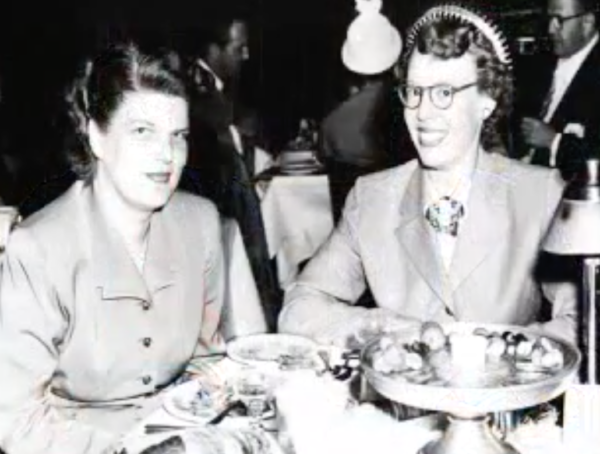
Del Martin and Phyllis Lyon (Screen grab from “No Secret Anymore”)
What about the dynamic of their own relationship, which Marcus understood was “the classic butch/femme relationship.”
“Well, I don’t know about the ‘classic’” Lyon said. “It didn’t work for us no matter how we tried. It was true that Del tended to light my cigarettes, okay? But that was as butch as she got sometimes. She doesn’t drive, and I did. You know, she didn’t drive the nails in and I did. She didn’t do any of these butch things.”
“I’m not at all mechanical,” Martin added
But wasn’t a butch/femme relationship “the relationship you thought you were supposed to have?” Marcus asked.
“Yeah, right. I remember thinking, well, now, let’s see, I’ve got to get Del’s breakfast every morning because that’s what mother did for dad. So, I did that for a week,” Lyon said. “Forget it. None of these things really worked for us and I suspect that was true for most couples.”
They had no lesbian role models.
“I didn’t know really much of anything. I mean, I just had met this person three-and-a-half years before and she said she was a lesbian, and I thought that was the most fascinating thing I’d ever heard,” said Lyon, noting that explained her own feelings. “But I didn’t really have a clue as to what that was all about.”
They knew about the bars in North Beach. But “we were very shy. And so, we sort of were more like tourists. Going to the bars and watching everybody and wondering how we fit in,” said Martin.
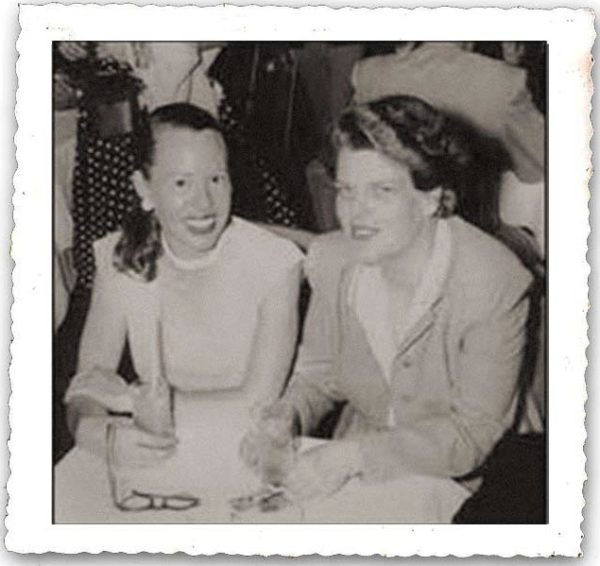
Phyllis Lyon and Del Martin (Photo from “Last Call at Maud’s”)
That first year in the Castro was difficult. Though they’d been close friends for three years, living together was another matter as Lyon and Martin tried to figure out their power differential based on heterosexual norms. Later they said a kitten given to them by a friend kept them together since they couldn’t figure out how to divide the pet.
Finally, they realized that they didn’t need to follow anyone else’s prescription. They were equals with strengths and weaknesses and they could just be themselves as women instead of caricatures.
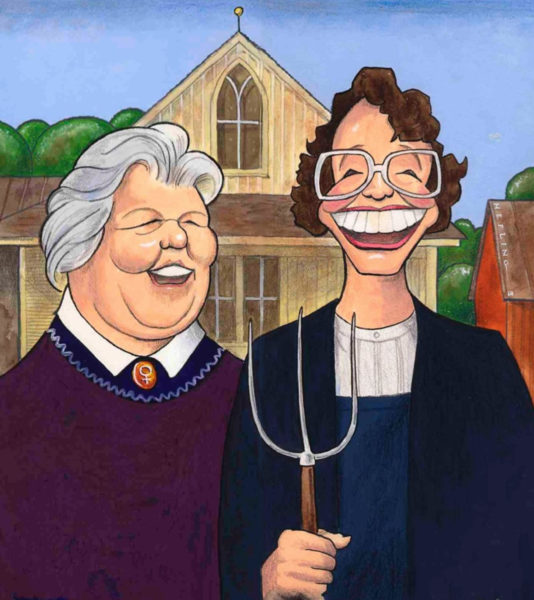
Illustration by Charles Hefling, originally published in The Gay & Lesbian Review. Used with permission.
That was a radically new concept for American women. What was it to be a woman, independent of a man instead of Adam’s rib?
It was a question in the air as a second wave of feminism wafted across Europe. “One is not born, but rather becomes, a woman,” wrote existential philosopher Simone de Beauvoir in The Second Sex, published in 1949.
Del Martin and Phyllis Lyon were living in the question.
“Our only tie with the gay world was our sense of ‘belonging’ to each other,” they wrote in Lesbian/Woman. “We needed to relate to gay people who would understand the subtle differences between heterosexual and homosexual relationships. We needed to know more about the gay life and how to manage in a straight society. Above all, we needed a sense of community with others like ourselves—the feeling of security and respect that a homogenous group affords its members.”
In 1955, the couple moved into a house atop a steep hill in Noe Valley with a great view overlooking downtown San Francisco. They paid $10,000, using a down payment from Lyon’s stash of war bonds.
They befriended a gay couple who lived around the corner. “They were in a butch/femme relationship,” Lyon told Eric Marcus.
Jerry was a bartender and “Ricky was very effeminate. He used to dress in drag. He and I used to dress alike sometimes, to go out, Halloween and stuff like that,” said Lyon. He stayed home and took care of the cats.
Jerry introduced them to lesbian Rose Bamberger who called to see if they wanted to start a secret club for lesbians as a safe alternative to the bars.
“We are erroneously given credit as the founders of the Daughters of Bilitis in San Francisco in 1955,” Lyon wrote in “Lesbian Liberation Begins” in the Nov. 1, 2012 issue of the Gay & Lesbian Review.
“It wasn’t even our idea. A young Filipina immigrant envisioned a club for lesbians here in the States that would give us an opportunity to meet and socialize (and especially to dance) outside of the gay bars that were frequently raided by police. Meeting in each others’ homes provided us with privacy and a sense of safety from the police and gawking tourists in the bars,” she wrote.
“There were eight of us in the beginning: four couples, four blue-collar and four white-collar workers, two lesbian mothers, and two women of color,” she added.
They named the new secret club the Daughters of Bilitis (DOB) “to sound like just another women’s lodge. Bilitis (pronounced Bil-E-tis) came from The Songs of Bilitis by Pierre Louÿs, a long narrative love poem in which Bilitis was cast as a contemporary of Sappho on the Isle of Lesbos. Presumably lesbians would know what the name meant. If anyone else asked, we could say we belonged to a Greek poetry club,” Lyon wrote.
In a 1992 interview with Terry Gross of NPR’s “Fresh Air,” Martin joked that, “It was supposed to be a secret, and we have spent many, many years now trying to explain the name.”
“The Daughters began in a climate of fear, rejection, and oppression,” Lyon wrote. “There was no sense of community as exists today. Lesbians were isolated and separated—and scared.”
In 1956, DOB discovered the Mattachine Society in San Francisco and ONE, Inc. in Los Angeles, both of which welcomed lesbians into their “homophile” movement but chided them for being separatists and not welcoming to gay men. It was a constant source of friction, though Lyon and Martin did become friends with some gay men, such as Jim Kepner, who wrote for ONE Magazine. He was an “honorary” DOB, he told this reporter, but as a SOB, Son of Bilitis. SOB was also a source of amusement, given it’s more mainstream use to mean “son of a bitch.”
“Along with parties and discussion groups, the early days involved a great deal of peer counseling to help overcome the stigma of being branded illegal, immoral, and sick by a hostile society,” Lyon wrote in GLReview.
Since outreach was difficult, DOB, with Lyon as editor, started publishing The Ladder in October 1956. “It included the four-fold purpose of DOB: 1) education of the variant to enable her to understand herself and make her adjustment to society; 2) education of the public to break down erroneous conceptions, taboos, and prejudices; 3) participation in research projects to further knowledge about the homosexual; 4) investigation of the penal code and promotion of changes through state legislatures,” Lyon wrote.
Under their mandate, DOB held “public” forums that allowed, Lyon wrote, “lesbians and some gay and transgendered men to attend without committing themselves. Professional speakers included attorneys who explained the law and told us what our rights were and what to do in case of arrest. Those in the mental health professions refuted the sickness theory and promoted self-acceptance. Our contention was that once you accepted yourself, regardless of what others had to say, you could cope better in a hostile society. The professionals who were among society’s decision makers gave us the validation we needed then.”
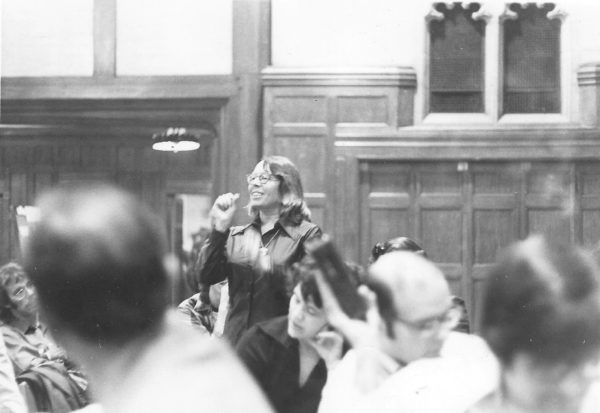
Phyllis Lyon (Screen grab from “No Secret Anymore,”1974, by Al Lopp, Bloomington Gay Alliance)
In Feb. 1957, DOB became a legal non-profit corporation.
At a Mattachine Society convention in Denver in 1959, Lyon and Martin squared off with homophiles who “assumed that whatever was said about homosexuality included lesbians, just like the generic term ‘he,’” Martin said “Lesbians are not satisfied to be auxiliary members or second-class homosexuals. …One of Mattachine’s aims is that of sexual equality. May I suggest that you start with the lesbian?’”
It’s a question still being asked today.
By 1968, DOB had evolved into from a strictly secret social club into an organization taking on persistent anti-LGBTQ issues. DOB’s research director, Florence Conrad (née Jaffy), thought it was important to survey the attitudes of professional psychiatrists, psychologists, and therapists. She gained the cooperation of Dr. Joel Fort, director of the Center for Special Problems at San Francisco’s Public Health Department, who developed a DOB-sponsored questionnaire with Claude M. Steiner that was distributed randomly to 153 Bay Area mental health professionals: 147 responded, 88 percent of whom were in private practice and had gay clients.
“The results,” Lyon wrote in GL Review, “were startling: 99 percent opposed laws treating homosexual acts between consenting adults as criminal,” a law that remained on California’s books until 1975. “So pro-homosexual were the results that it took almost three years to find a publisher (Psychological Reports in October 1971).”
The results “vindicated DOB and played a role in the eventual removal of homosexuality per se from the American Psychiatric Association’s Diagnostic and Statistical Manual,” Lyon wrote.
But by 1972, DOB and The Ladder had faded from view. Lyon and Martin, however, persisted, politically supporting Dianne Feinstein and Nancy Pelosi, among many others.
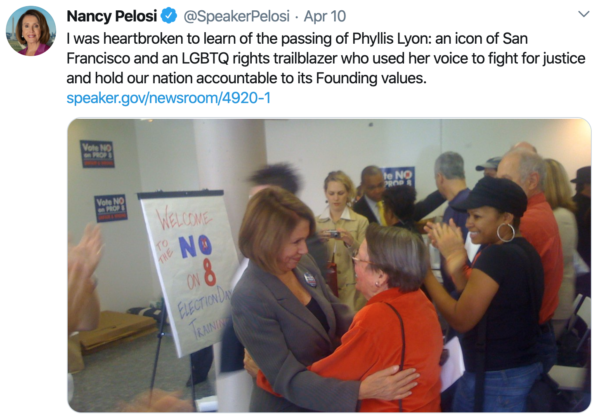
On June 25, 1989, the 20th anniversary of the Stonewall riots, Phyllis Lyon and Del Martin served as grand marshals of San Francisco’s Gay Freedom Day Parade.
“We were trying to help lesbians find themselves,” Lyon told Eric Marcus. “I mean, you can’t have a movement if you don’t have people that see that they’re worthwhile.”
Despite the darkness, fear and struggle, Lyon and Martin shouldered the burden and forged a new path to equality. Their impact as guides and role models continues to have powerful ripple effects.
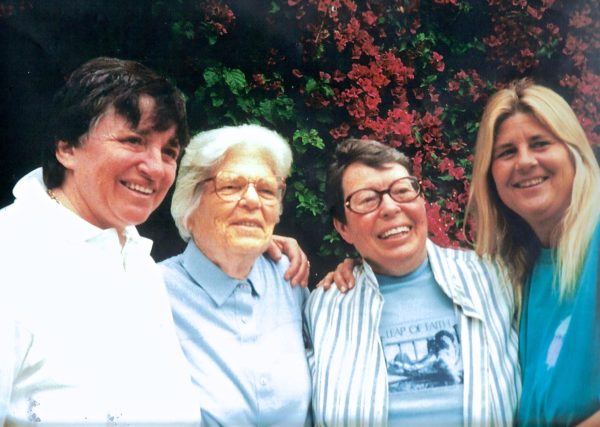
Robin Tyler, Del Martin, Phyllis Lyon, Diane Olson (Photo courtesy Robin Tyler)
“In 1959, when I was 17 years old, I got a crush on another girl at the Banff School of Fine Arts in Canada. I ran down to the bookstore and found a booklet called ‘The Ladder.’ In it was written: ‘If you are a woman and you love another woman, what you are is a lesbian. Everybody can tell you it is wrong, but if it feels right to you, it is right,’” longtime lesbian and marriage equality activist Robin Tyler tells the Los Angeles Blade. “Because of them, I was not in the closet for one minute after that.”
Lesbian/Woman also impacted many lives.
“The year is 1972. I’m standing in the checkout line of a typical large grocery store in the South Bay contemplating whether I’m going to ever be able to openly love a woman when I look up and in the paperback book by Phyllis Lyon and Del Martin named Lesbian Woman. That paperback book changed my life. It gave me the courage to leave my husband, fight to keep my children and learn to say, ‘I am a lesbian,’” longtime political activist Diane Abbitt tells the Los Angeles Blade.
In an Aug. 2008 interview, then- Mayor Gavin Newsom, who was being honored by Equality California, reflected on the significance of marriage in the face of Prop 8:
“I just got married last week – and I felt we were together a long time and it’s a year and a half. I couldn’t wait to get married. I could only imagine couples that have been together for decades and the struggle and the despair. And the resignation, almost – that you just never imagine it would happen in your life – so there’s not even the expectation that it could. And now all that’s changed and that’s what’s so important about November. What’s at stake is so much more palpable than we could have ever intellectualized it six months ago or even three months ago.”
Politico Bob Burke, San Fransisco Mayor Gavin Newsom and attorney and EQCA board co-chair Diane Abbitt in Los Angeles August 2008 (Photo by Karen Ocamb)
Asked about the marriages of Phyllis Lyon and Del Martin, Newsom said:
Ah, come on. That was as good as it gets. The whole thing started with them. In 2004 it was all about putting a human face on discrimination and no greater narrative, no greater love story than theirs and to be able to do it then, to go through the travail of the nullification, and then to come back four years later, I got to tell you candidly – never thought I would have that opportunity in my life, certainly not as mayor still and it was liberating, it was glorious, it was extraordinary.
And it wasn’t just Phil and Del – it was their family, it was their friends and I understand this now better than ever because our wedding was about our families – it wasn’t just about Jen and I.
And that’s also something that’s so important to communicate in the next few months – that it’s not just about the LGBTQ community. This is about all of us. This is about our families and friends. This is about people coming together across their differences. And that’s something that I think is very unifying and so fundamental.
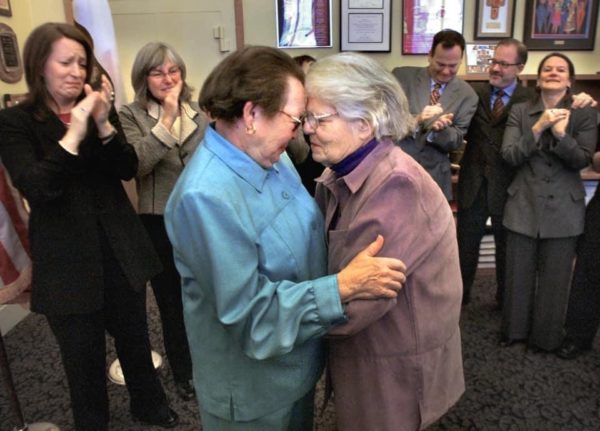
Phyllis Lyon and Del Martin married in 2004 as Kate Kendell, Roberta Achtenberg, and Joyce Newstat (Photo Liz Mangelsdorf courtesy Kendell)
“Phyllis was a light in my life and in the life of our community,” says Roberta Achtenberg, who became the first highest ranking out person in the federal government during the Clinton Administration. “She and Del were the mothers of our movement. They gave us so much—and asked very little— except that we continue the struggle until we prevail.”
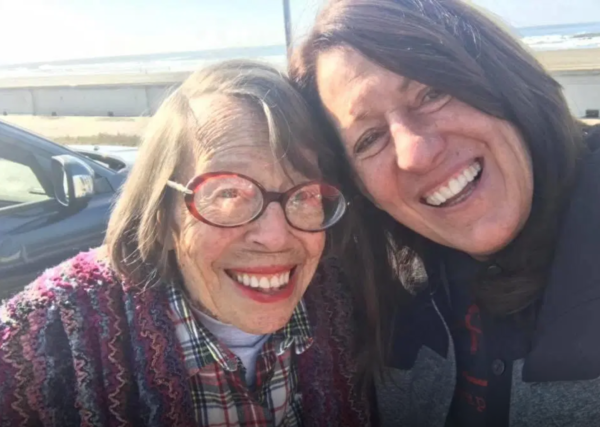
Phyllis Lyon and Kate Kendell (Photo courtesy Kate Kendell)
Lyon’s death has been hard for Kate Kendell, former executive director of the National Center for Lesbian Rights who conspired with Newsom and Newstat to create that 2004 marriage.
“I am living the duel reality of this is exactly what I would have wished for her – to be 95, to be able to die at home with care givers who have been part of her life and family for several years now. Getting phone calls from close friends who just told her stories. And being able to be comforted, not in pain, and then walk through the door to whatever is next. And thinking that I won’t have Phyllis,” says Kendell, pausing to recall her last visit.
“She just took my hand and said, ‘You are a real sweetie.’ And I said, ‘Well, Phyllis, I love you.’ “And I love you, too, sweetie,’’ Kendell says. “I’m going to miss her every day.”
![]()
LGBTQ PIONEERS attend 1998 memorial for Jim Kepner in Los Angeles. First row from left Lisa Ben, Harry Hay, John Burnside, Jose Sarria, Del Martin, Phyllis Lyon; (second row) Fred Frisbie, Bob Basker, Frank Kameny, Florence Fleischman, Hal Call, Robin Tyler; (third row) Philip Johnson, Eddie Sandifer, Vern Bullough, Malcolm Boyd; (fourth row) Barbara Gittings, Kay Tobin Lahusen, Jack Nichols, Mark Segal, unidentified; (fifth row) Cliff Anchor, Leo Laurence, Eldon Murray, John O’Brien, and Jerome Stevens. (Photo courtesy Robin Tyler; photo IDs thanks to Michael Bedwell)
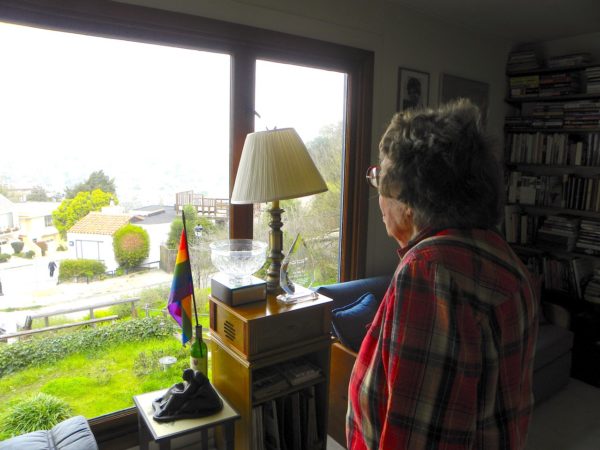
Phyllis Lyon looking out over downtown San Fransisco (Photo by Karen Ocamb)
Arts & Entertainment
A Night of legacy, love, and liberation: Inside the 2025 April Fool’s Ball
Ballroom culture continues to thrive among Black and Latin American queer culture

Late last month, the West Coast Ballroom Community lit up Los Angeles for one of the most anticipated events of the year — the April Fool’s Ball — produced by Legendary Father Markus Tisci. Now a staple of the L.A Ballroom calendar, the annual event is known not only for its high-caliber talent and unforgettable battles but for the legacy, love and chosen family it uplifts.
But let’s be clear: when we talk about “Ballroom,” we’re not talking about waltzing under chandeliers, we’re talking about the underground queer subculture birthed from the genius and resistance of Black and Latin American queer people — especially trans women and drag queens — in New York City.
Ballroom has since shaped and influenced mainstream culture, as seen in moments like Madonna’s “Vogue,” Beyoncé’s “Renaissance” and shows like “Pose” and “Legendary.” Today, that legacy continues to evolve and flourish far beyond New York, thriving in cities across the West Coast and beyond.
Markus Tisci has been a part of that movement for over 18 years and his roots trace back to the House of Rodeo — one of the West Coast’s most iconic original houses. In 2018, he founded the April Fool’s Ball with a simple but powerful goal: to bring laughter and creativity back into a space that was becoming, ‘a bit too serious.’ Conceived, produced and largely self-funded by Tisci, the ball is still known for its playful, pop culture — inspired categories that encourage imagination and joy.
Highlight the reel from the night of the House of Gorgeous Gucci.
This year’s April Fool’s Ball was filled with emotion, celebration, and remembrance. Just a few days earlier, the community laid Icon Devine to rest. The passing of the Queen of the West Coast Ballroom Scene and Legendary Mother of the West Coast Chapter of the House of Gorgeous Gucci left a deep void. For Ballroom Icon Jack Mizrahi, one of the night’s emcees and a foundational figure in Ballroom culture — as well as the father and founder of the House of Gorgeous Gucci — the event became a moment of both grief and healing.
“Seeing my house assembled, having each other to lean on, and the love we got from the whole West Coast Ballroom scene — it meant everything,” he shared.
In a powerful moment during the Legends, Statements and Stars (LSS) call — a time at the beginning of every ball when individuals are recognized and honored for their influence and impact — Mizrahi invited all trans women, whether they were walking or not — to step forward.
“Let the world know they deserve to be safe, protected, loved, and respected,” Mizrahi declared.
As the crowd cheered, those women (including the author) took their place with pride, their presence a radiant tribute to Icon Devine’s legacy and the enduring spirit of trans brilliance that Ballroom has always celebrated.
Fem Queen Parade at April Fools Ball 2025
The crowd erupted during the “Overall Face” final battle, where Jozea Flores — an up-and-coming Ballroom Legend in the House of Gorgeous Gucci — took home the grand prize of $1,000. In the “Face” category, contestants are judged on their natural beauty, expression, and how well they can ‘sell’ their face.
“When two stunning faces battle, you have to see who’s selling it more. That night, I sold it.” For Jozea, it’s about more than cash or trophies, though. “The energy from the crowd is my favorite part,” he shared. His message to the queer community: “Keep being true to yourself. Live boldly. Live loud.”
Royal Telfar Tisci, a fierce presence in “Gender Non-Conforming Runway,” also left their mark.
“It felt like old-school Ballroom energy,” they shared. “It was my first time walking at 5 a.m. — wild, but so worth it.” Royal walked with pride, earning their 10s and winning three battles.
“Runway is where we should shine. And that night, I did. But it raises the question — why aren’t GNC folks being included more consistently?”
As both a performer and advocate, Royal knows what’s at stake.
“There are forces trying to erase queer people, Ballroom, and especially the trans women who built it. We have to stay resilient, come together, and stay proud.”
Though Royal never lost to a competitor, the final battle and $3,000 grand prize was won by their chosen family member, Legendary Envy Tisci, the Bay Area Father of the House of Tisci.
“The night was long, but I enjoyed creating moments,” said Tisci. “I don’t get wrapped up in winning — I focus on the memories.”
Even as the night stretched into the early morning, the energy never faded. Destiny Ninja, Princess of the West Coast Chapter of the Iconic House of Ninja, delivered a voguing performance that closed the night with intention. She won “Women’s Performance” and after winning three battles, made it to the final battle in “Overall Performance.”
“I had so much to express and the runway was the perfect place to release it all,” she said.
The April Fool’s Ball continues to hold space for legacy and liberation. In the wake of Devine’s passing, the night became a reminder of the community’s strength.
“[Tisci] deals with applause, scrutiny and everything in between,” said Mizrahi. “And he still shows up. We need to stay united. Devine fought hard for visibility and respect. The West Coast needs to honor that — not with division, but with love.”
Tisci reflected on the night.
“Devine was a trailblazer—our Queen of the West Coast. Her impact still shapes the next generation. She’ll always be in our hearts. Tonight was about growth, legacy, and keeping the energy alive.”With the next major event — The Legacy Ball scheduled for June 1 — the community is already looking ahead. In a time of uncertainty and political hostility, the April Fool’s Ball re-affirmed what Ballroom has always been: not just a scene but a sanctuary. A home. A lifeline.
History
Los Angeles Blade celebrates 8 years!
SoCal’s LGBTQ+ news source celebrates 8 years of news catered to the LGBTQ+ community in print and online
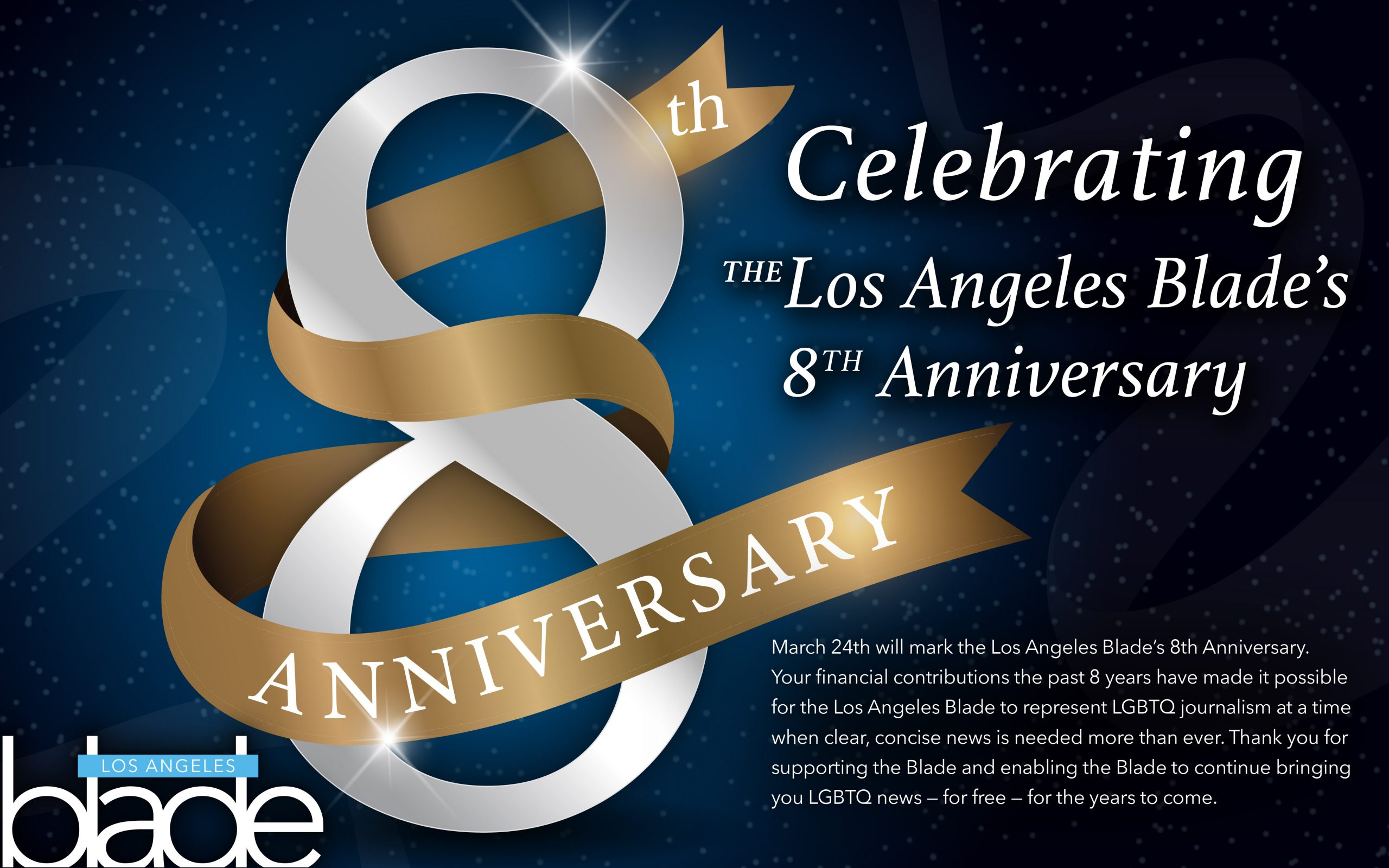
March 24th marks the 8th anniversary of our newspaper. Even as the political attack on the queer community wages on, we continue the legacy that Los Angeles Blade founder Troy Master began. Our promise to the LGBTQ community is to continue to bring you the latest in political, social, entertainment, nightlife, and activist news, for and by the community. Our voice will stay steady and strong and remain the leading news source for and by the queer community.
In addition to bringing you the latest in news, we will continue to highlight leaders from the community from the social and political world. Our initiative to build bridges with the Latinx community continues through our close relationship with CALÓ NEWS with weekly reporting on issues that affect both groups. This year we will be kicking off Pride season with the return of our Best in LA Awards show, coming back bigger and better than ever.
Among our new initiatives this year, we are returning to the community with a series of free panels and discussions, covering important issues that are affecting the community, queer and beyond. We will be working with our power partners from the non-profit world, government offices, and social organizations to remain active and visible in an effective way.
We are also growing our local writing team to better reflect the diversity that exists around us.
We continue to be Los Angeles’ only LGBTQ bi-weekly newspaper and the City’s largest, most frequently distributed media in print and online. Our sister newspaper, The Washington Blade, is the nation’s longest-running LGBTQ newspaper founded in 1969. It is also the only LGBT media member of the White House Press Corps.
As the new publisher of the Los Angeles Blade, I will work hard to honor the brand of The Blade and the work that Troy, our previous journalists and editors, and our community partners did to make us who we are today. A very heartfelt thank you to our readers and advertisers who continue to support our efforts.
Despite what is going on socially and politically towards the queer community, we will continue to thrive.
Alexander Rodriguez, Publisher
Please consider supporting the continuing efforts of the Los Angeles Blade with your financial contribution. For just dollars a month, your support makes vital LGBTQ journalism possible at a time when clear, concise news is needed more than ever.
For advertising opportunities, please contact Alexander Rodriguez at [email protected]
Today marks our 8th anniversary as SoCal’s LGBTQ+ news source and we want to thank you all for the support through the years. The Blade was founded in 2017 by Troy Masters, two years after he moved to Los Angeles in search of community and a fresh start for the next stage in his journalism journey.
He founded the Los Angeles Blade, because he saw the overwhelming need for accurate and unbiased news reporting for the LGBTQ+ community during a time where many other mainstream news outlets were overlooking the stories that affected our communities, such as the AIDS crisis.
In our everyday work since then, we aim to cover the issues that not only affect us, but that also inform us and spotlight our amazing talents, skills and ability to unite. We always aim to be a beacon of light, education and information for our communities because under this current administration, Trump has seemingly vowed to take us back into the dark ages and erase any and all progress we have painstakingly made throughout time.
My goal as editor is to include voices that make up our community and continue building trust with those voices, so that our work can serve you and everyone else under the LGBTQ+ and QTBIPOC umbrellas.
It’s true, Democracy dies in darkness and as members of the media, we must double-down in our efforts to provide accurate, informative and relevant news to our communities now more than ever.
The Blade has seen leadership shifts within the last six months, including myself, and we hope that these changes encourage you to support us and see how we continue growing.
Please reach out to us to discuss how we can better serve you or our communities. Don’t forget to subscribe to our weekly newsletter and donate to the Blade Foundation if possible.
Thank you all so much for your trust and support during these particularly difficult times.
Gisselle Palomera, Editor
Contact me at [email protected].
History
LGBTQ+ History Archive Gains Momentum: Personal Stories Project Partners with George Takei
Increased Awareness Through Social Media Reach

The LGBTQ+ History Archive Personal Stories Project is experiencing a surge in submissions. This decade-long effort documents LGBTQ+ history through personal narratives. Its success stems from a new partnership with actor George Takei and the .gay domain provider.
Charles Chan Massey co-founded and directs the Personal Stories Project. He credits the partnership’s success to Takei’s vast social media following. Takei, a vocal LGBTQ+ rights advocate, encouraged his 3.3 million X followers to share their stories.
Takei posted: “Each of us in the LGBTQIA+ community has a powerful coming-out story to tell. I want to hear yours. Head over to personalstories.gay today. Fill out the form to be featured on the Personal Stories website. I’ll be sharing some throughout the month to inspire others.”
Amplifying Community Voices
Logan Lynn is the creative director of .gay Domains. He emphasizes the partnership’s role in amplifying vital LGBTQ+ voices.
“Pride is about honoring and celebrating the depth of our communities,” Lynn said. “What better way to showcase this than through stories from people living LGBTQIA+ lives?”
Preserving Everyday Stories for Future Generations
Massey founded the LGBTQ+ archive project in 2012. His mission: preserve narratives of ordinary LGBTQ+ individuals, not just prominent figures.
“I wanted to archive our community’s history,” Massey explained. “Not just prominent members, but regular people who needed a platform. Regular people can identify with regular people. It’s important to see someone just like you.”
Massey maintains an online archive. This ensures accessibility of these oral histories for the LGBTQ+ community.
“As long as the internet exists, it can archive our stories,” Massey said. “We’re preserving stories for future generations. We’re also helping people find others with similar journeys.”
From Facebook Page to Registered Charity
The LGBTQ+ History Archive Personal Stories Project started as a simple Facebook page. It has evolved into a dedicated website and registered charity. It now supports LGBTQ+ organizations across the US and Canada.
Many participants share how LGBTQ+ organizations helped them. The Personal Stories Project encourages donations to these charities. Massey reports raising $15,000 to $25,000 annually for over 20 non-profits.
“95% of our budget goes to other 501(c)(3) organizations,” Massey said. “We support large and small community-based groups. A $200 donation can make a significant difference.”
A Diverse Collection of Experiences
The Personal Stories Project has a vast collection of LGBTQ+ stories. Massey is often struck by the depth of experiences shared.
“I met Peter, who was 85 at the time,” Massey shared. “He served in the Air Force, modeled in the 1940s, started an ad agency, and lived through the AIDS crisis. His story shows the power of these narratives.”
The project seeks submissions from all parts of the LGBTQ+ community. This includes people of various ethnicities and generations.
“People often think their story isn’t interesting,” Massey said. “But when they share, it’s captivating! Someone will identify with your story. Sharing is a powerful gift and a responsibility.”
Share Your Story
Do you have an LGBTQ+ story to share? Visit personalstories.gay to contribute to this important historical archive.
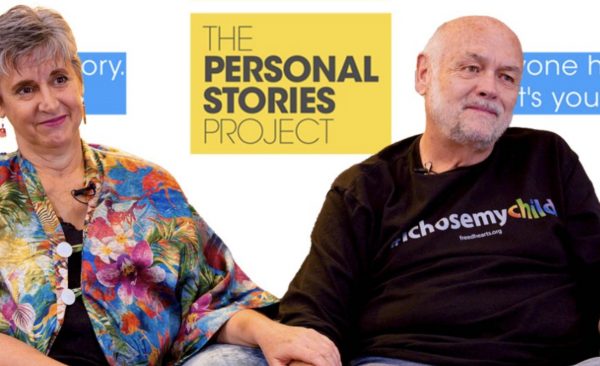
Image from Personalstories.gay website
History
The world-changing decision by psychiatrists that altered gay rights
December 15, 1973, was hailed by gay rights activist Frank Kameny as the day “we were cured en masse by the psychiatrists”
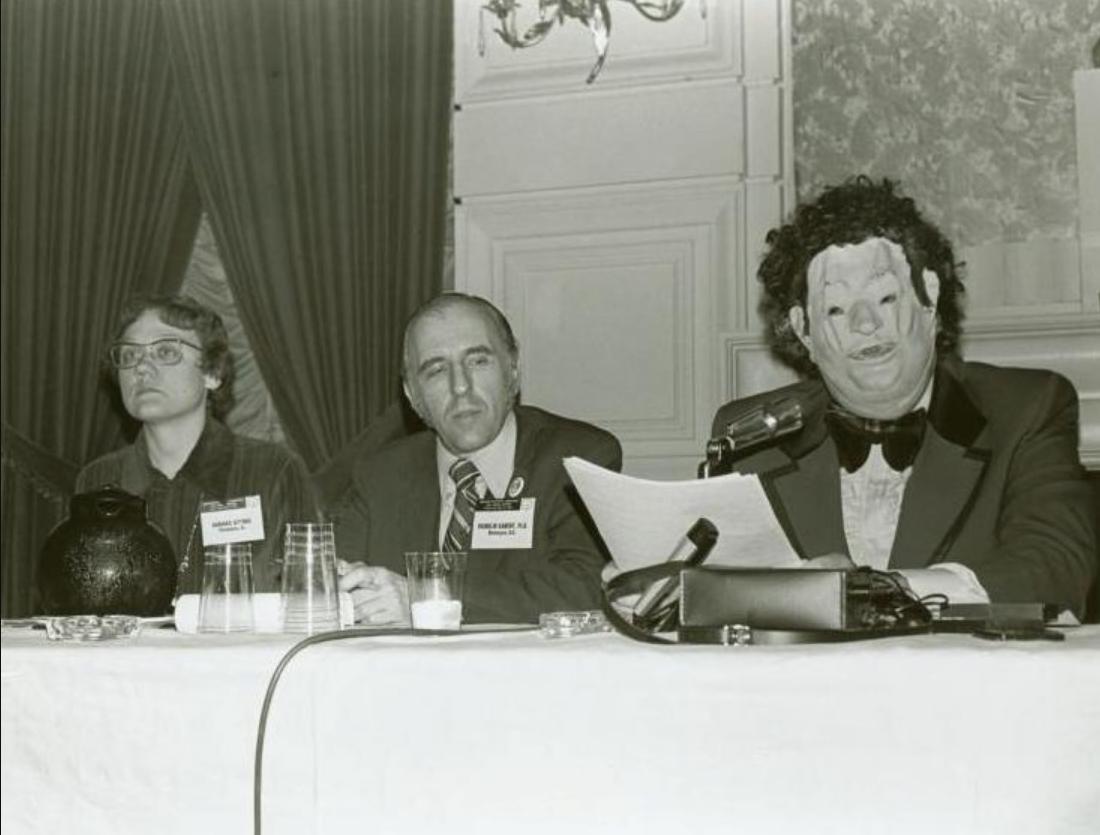
WASHINGTON – Fifty years ago this past Friday, on December 15, 1973, a decision by the American Psychiatric Association (APA) at its annual convention was hailed by gay rights activist Frank Kameny as the day “we were cured en masse by the psychiatrists.”
The board of trustees of the APA voted to remove homosexuality from its Diagnostic and Statistical Manual of Mental Disorders, which is used by health care professionals in the United States and much of the world as the authoritative guide to the diagnosis of mental disorders.
Washington Post writer Donald Beaulieu noted in an article published on the 50th anniversary that newspaper stories the next day mostly treated it as a technical change rather than a seismic shift that would transform the lives of gay people. But for gay rights activists Barbara Gittings, Kameny, Paul Kunstler, Jack Nichols, Elijah ‘Lige’ Clarke, Lilli Vincenz, and Kay Tobin Lahusen, it was groundbreaking.
Kameny and Nichols in 1961 had formed The Mattachine Society of Washington, D.C., that the others were actively engaged in with the purpose of conducting gay rights protests at the White House, the United States Civil Service Commission, and the Pentagon. By the late 1960’s the group also focused on efforts to declassify homosexuality as a mental illness.
Kameny and Gittings were determined to get the APA to act. Nichols, Clarke, Gittings and Lahusen would create some of the earliest gay themed content, stories and columns in early gay national publications.
Nichols with his partner Clarke, wrote the column “The Homosexual Citizen” for Screw magazine, a pornographic ‘straight’ tabloid publication in 1968. Lahusen’s photographs of lesbians appeared on the cover of The Ladder as Gittings worked as its editor. The Ladder, published by the Daughters of Bilitis (DOB), was the first national lesbian magazine.
In the August 1964 issue of The Ladder, Gittings’ editorial blasted a medical report that described homosexuality as a disease, writing that it treated lesbians like her more as “curious specimens” than as humans.
In 1971, some seven years later at the annual meeting of the APA, Gittings, Kameny and fellow gay activists stormed the meeting and Kameny seized the microphone, demanding to be heard. The Washington Post reported:
Kameny, who had lost his job as an astronomer with the Army Map Service in 1957 because he was gay, grabbed the microphone from a lecturer at the convention and addressed the room. “Psychiatry is the enemy incarnate,” he told the shocked audience. “Psychiatry has waged a relentless war of extermination against us. You may take this as a declaration of war against you.”
For the APA’s annual meeting in 1972, Kameny and Gittings organized a panel on homosexuality. When no gay psychiatrist would serve on it openly for fear of losing his medical license and patients, Gittings recruited Dr. H. Anonymous (John E. Fryer, M.D.), who appeared masked and using a voice modulator.
Gittings, Kameny and Dr. Anonymous asserted that the disease was not homosexuality, but toxic homophobia. Consequently, the APA formed a committee to determine whether there was scientific evidence to support their conclusion.
The Post noted: “This is the greatest loss: Our honest humanity,” Fryer said. “Pull up your courage by your bootstraps and discover ways in which you and homosexual psychiatrists can be closely involved in movements which attempt to change the attitudes of heterosexuals — and homosexuals — toward homosexuality.” Fryer received a standing ovation. He would not reveal his identity until 1994, 22 years later.
“In 1973, with Gittings and Kameny present by invitation, the APA announced its removal of the classification. Kameny described it as the day “we were cured en masse by the psychiatrists.” At the time, the “cures” for homosexuality included electric shock therapy, institutionalization and lobotomy. With the APA’s retraction, the gay rights movement was no longer encumbered by the label and its consequences.”
A symposium to address the issue occurred at the APA convention in Honolulu in May 1973 the Post reported. Panel members would represent both sides of the argument. There were those who fought the reclassification including one speaker who advocated retaining the homosexuality diagnosis, Charles Socarides, who received mostly boos from the crowd. Socarides asserted during the discussion, “All of my gay patients are sick.” According to Lawrence Hartmann, a psychiatry professor at Harvard University who served as APA president in the early 1990s, another panelist replied, “All of my straight patients are sick.”
According the Post, the last to speak was Ronald Gold, media director for the Gay Activists Alliance and the only panelist who was not a psychiatrist. Gold, who as a child was subjected to aversion therapy by a psychoanalyst, told the packed ballroom, “Your profession of psychiatry — dedicated to making sick people well — is the cornerstone of oppression that makes people sick.” Gold’s speech got a standing ovation, just as Fryer’s had the year before.
The legacy of that December decision fifty years ago continued when in 1998, the APA announced that it opposed any psychiatric treatment, such as “reparative” or conversion therapy, which is based upon the assumption that homosexuality per se is a mental disorder or that a patient should change his/her homosexual orientation.
In 2005, the APA established The John Fryer Award, which honors an individual who has contributed to improving the mental health of sexual minorities. The award is named for Dr. John Fryer, a gay psychiatrist who played a crucial role in prompting APA to review the scientific data and to remove homosexuality from its diagnostic list of mental disorders in 1973.
Out gay psychiatrist Amir Ahuja, who serves as president of the Association of LGBTQ Psychiatrists, told the Blade at an event celebrating the 50th anniversary of the historic speech by then closeted Fryer, that the positive outcome from Fryer’s efforts has had a direct impact on his own career.
“I would say I think John Fryer opened the door for me to have a career and many of my colleagues who are LGBTQ+ psychiatrists in order to work in a field where we’re not stigmatized as having an illness,” Ahuja said. “Because we could have lost our job. That’s what happened to John Fryer multiple times,” according to Ahuja. “Before he gave that speech, he had lost two residencies at least. Because of his sexuality, people were discouraging him from continuing in the profession.”
“John Fryer’s courageous actions were a watershed moment for psychiatry, the APA, and the LGBTQ community,” said Saul Levin, M.D., M.P.A., CEO & Medical Director of the American Psychiatric Association. “Every day we work to honor the legacy of Dr. Fryer and the activists who fought alongside him to achieve freedom, equality and acceptance for LGBTQ people in America.”
Additional reporting by Lou Chibbaro Jr.
History
Don’t ask – don’t tell, a Veterans’ Day reflection
On Sunday, Nov. 12 at 10 p.m. ET on MSNBC, and streaming on Peacock, ‘Serving in Secret: Love, Country, and Don’t Ask Don’t Tell’ will air
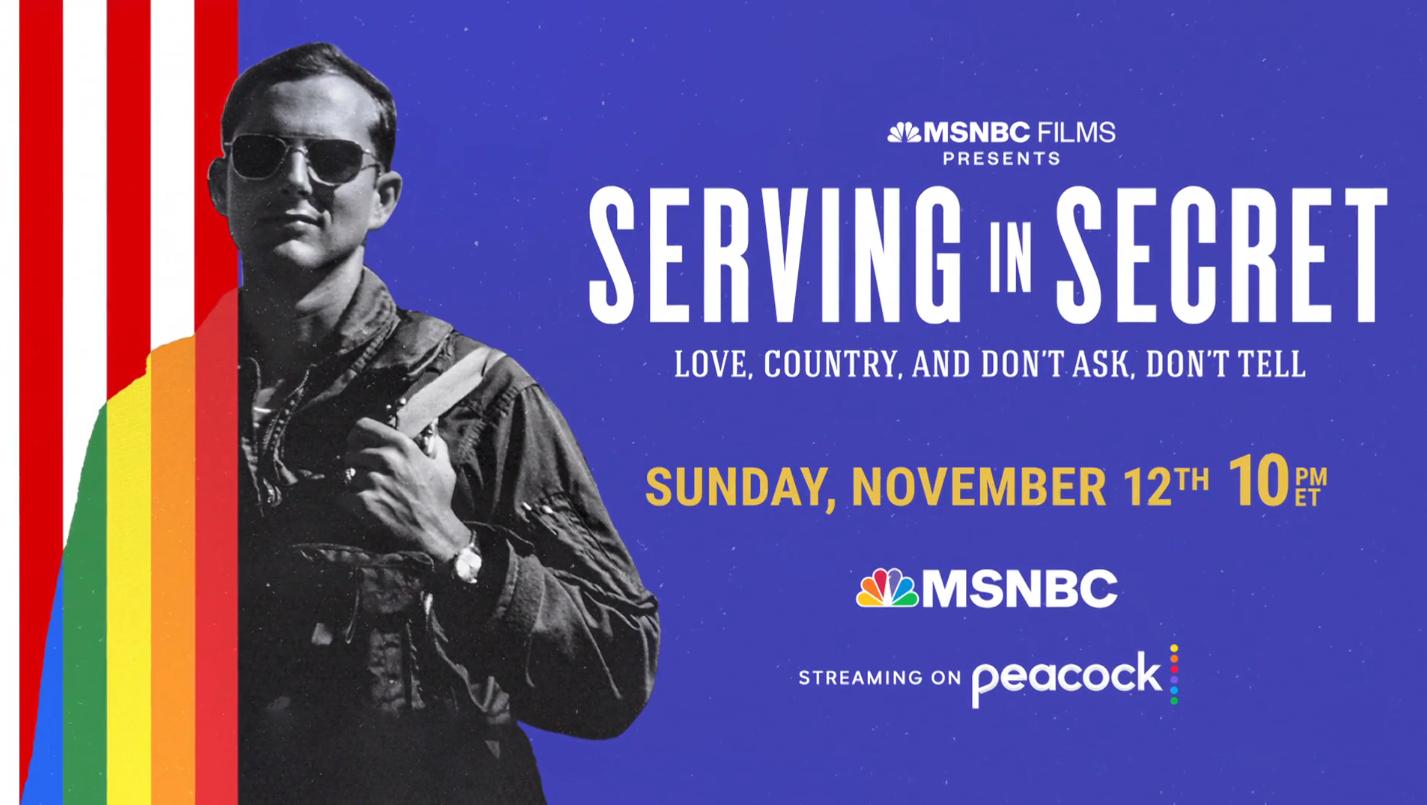
LOS ANGELES – On December 18, 2010, the U. S. Senate overturned the “Don’t Ask, Don’t Tell” policy by a 65-31 vote, which President Barack Obama signed a few days later.
As LGBTQ veterans mark Veterans’ Day 2023 today, the Los Angeles Blade takes a look back at a series of policies that marginalized and persecuted the LGBTQ community’s military service, and the activists who successfully pushed the government to repeal them.
Don’t Ask – Don’t Tell Repeal Act of 2010
During World War II, the U.S. Armed Forces established a policy that discharged homosexuals regardless of their behavior. In 1981, the Defense Department prohibited gay and lesbian military members from serving in its ranks with a policy that stated, “Homosexuality is incompatible with military service.” In the decade following, 17,000 service members were discharged from their duties for being homosexual.
This spurred a new policy called “Don’t Ask, Don’t Tell” during the Clinton Administration. In November 1993, the Defense Authorization Act put “Don’t Ask, Don’t Tell” into effect, allowing gay and lesbian citizens to serve in the military as long as they did not make their sexual orientation public. Commanders were prohibited from inquiring about a service member’s orientation provided that they adhered to this condition. Additionally, the policy forbid military personal from discriminating against or harassing closeted homosexual service members and applicants.
By 2008, more than 12,000 officers had been discharged from the military for publicizing their homosexuality. On December 18, 2010, the Senate overturned the “Don’t Ask, Don’t Tell” policy by a 65-31 vote, which President Barack Obama signed a few days later. The repeal allows gay and lesbian military members to serve openly in the armed forces.
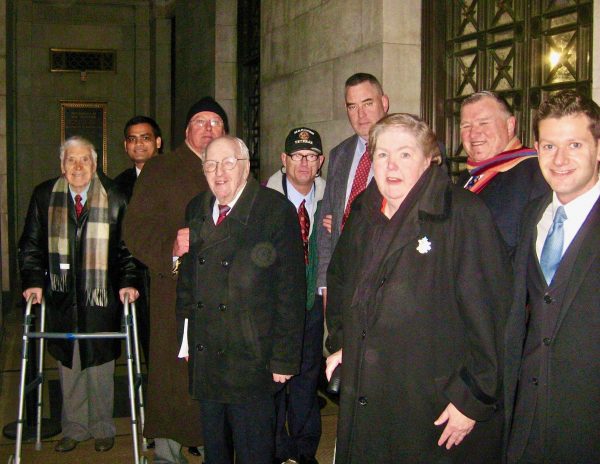
Left: (using walker) Dr. John Cook from Richmond VA and his assistant; SLDN Board Chair Tom Carpenter; Mattachine Society of Washington DC founder Frank Kameny; retired Marine Sgt. Tom Swann; unidentified tall guy: Pat Kutteles, mother of murdered infantry soldier Barry Winchell; politico David Mixner; and SLDN attorney Aaron Tax.
(Photo courtesy Tom Carpenter)
On the anniversary of the Don’t Ask, Don’t Tell Repeal in 2018, former SLDN Board Chair Tom Carpenter wrote a reflection for the Los Angeles Blade:
“Many in our community never understood why any LGBT citizen would ever want to become part of a military that proclaimed “Homosexuality is incompatible with military service,” often sending LGBT service members to prison because of who they loved. The hard-core anti-war/military crowd wanted no part in the fight to lift the ban on open service. Bowing to these objections, many large LGBT organizations paid nothing more than lip service to this effort.
As a candidate, Bill Clinton promised to lift the ban. Clinton had no idea the forces that opposed this change in policy. Those of us, who had served, knew better. The military and Senate leadership blocked him, including members of his own party. Instead of a policy, in 1993, we ended up with a federal law—“Don’t Ask, Don’t Tell.” (DADT). This law proved almost as bad for LGBT service members as the outright ban.
Shortly after the law went into effect, two young lawyers, former Army Captain Michelle Beneke and Dixon Osburn, established Servicemembers Legal Defense Network (SLDN). They realized other LGBT organizations had neither the desire, nor expertise, to take on the task of providing legal assistance to those who would likely run afoul of the law. Their ultimate goal was to repeal the law in its entirety, allowing for open and honest service.
I joined the board of SLDN in 1994 and served as its co-chair for 7 years. It was clear to us that it would be another 10-20 years before Congress would be willing to take up this hot-button issue again. During the administrations of George W. Bush from 2000-2008, we felt as if we were in the wilderness. Thousands of service members were being discharged as the military asked, and some LGBT service members told. SLDN provided legal assistance to many and saved numerous careers.
Our arguments of how unfair the law was, and how much it was costing taxpayers to train replacements for highly skilled service members who were discharged, gained little traction. Sadly, it was the brutal murders of a sailor, Allan Schindler, and a soldier, Barry Winchell that finally focused attention on why this law was counterproductive to military readiness, unit morale and discipline. Both these young men were brutally beaten to death because one of their fellow service members merely thought they were gay.
These two tragedies captured the attention of the country. At SLDN, we recognized it was personal stories that would humanize this fight for equality. The mother of Schindler, as well as the parents of Winchell actively participated in SLDN’s lobbying efforts on Capitol Hill. Their emotional appeal to members of Congress was powerful. But it was not enough.
Our strategy was to have veterans in the forefront of the lobbying and media effort. Especially effective were those who had been discharged, resigned their commissions, or did not reenlist because of their sexual orientation. The most compelling personal stories came from Arabic linguists, medics, pilots, and infantrymen who had been on the front lines in the Global War Against Terror. Many of these veterans appeared on television and had their stories reported by the press. Through these efforts, it was becoming ever more clear to the public, the law was not working. These veterans made the case by revealing the simple truth—the law was contrary to the core values of the services. It required them to live a lie.
It was not until Barack Obama was elected in 2008 that we started to see an end game. With a Democrat in the White House and a more friendly Congress, we continued our strategy of telling personal stories. By this time over 12,000 patriots had lost their careers. There was much foot dragging from the White House during the early part of President Obama’s first term. The memory of what had happened to President Clinton’s effort, sixteen years earlier, clearly impacted the willingness to spend political capitol on this issue.
By 2010, SLDN marshaled Congressional allies and helped draft a bill to repeal DADT. It was becoming clear SLDN”s media and lobbying efforts had changed public opinion. Most Americans now favored repeal of DADT. Further, the Pentagon was being threatened by a series of lawsuits that challenged the law. The turning point was when the Senate held hearings and Secretary of Defense Robert Gates testified he favored repeal. In contrast to 1993, the Joint Chiefs of Staff agreed.
In the lame duck session of the 111th Congress, notorious for inaction, a true miracle occurred. In a stroke of legislative brilliance, led by Army veteran, Congressman Patrick Murphy, DADT was repealed. On Dec. 22, 2010, President Obama signed the repeal law.
With the repeal of DADT, the first leg of institutional bias had collapsed. As predicted, in 2015, after a tremendous effort by LGBT groups, the Supreme Court ruled all Americans, regardless of sexual orientation, had a fundamental right to marry.
The only institution remaining in the way of equality is ministry. “Religious liberty” is now the rallying cry of the opponents of freedom for all Americans. While progress is being made, many battles still lie ahead. Never give up!”
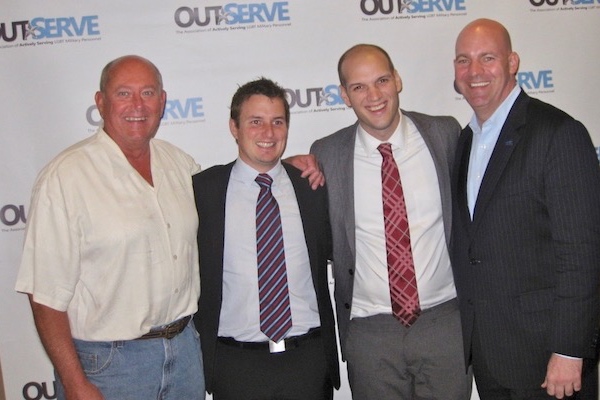
(Photo by Karen Ocamb)
On Sunday, Nov. 12 at 10 p.m. ET on MSNBC, and streaming on Peacock, ‘Serving in Secret: Love, Country, and Don’t Ask Don’t Tell’ will air:
In 1970, Tom Carpenter graduated from the Naval Academy ready to follow his family’s lineage in the military as a US Marine Corps attack pilot. Then he met Courtland Hirschi. Tom and Court fell deeply in love, keeping their illicit relationship a secret. At that time, homosexuality – if discovered – resulted in being kicked out of the military with a dishonorable discharge, a court martial, jail time, or worse… Tom and Court’s story would be no exception. ‘Serving in Secret’ features leading voices in politics, historians, civil rights activists, and retired military personnel telling the story of LGBTQ discrimination in the military, and the controversial compromise known as “Don’t Ask, Don’t Tell.” Tom’s work towards its repeal along with many others was the Turning Point for LGBTQ+ rights, a fight that continues today.
‘Serving in Secret: Love, Country, and Don’t Ask Don’t Tell’ (Link)
History
Hate: The bombing of the 16th Street Baptist Church remembered
Sixty years after four little girls were killed in the bombing at the 16th Street Baptist Church, at 10:22 a.m., the church rang its bells
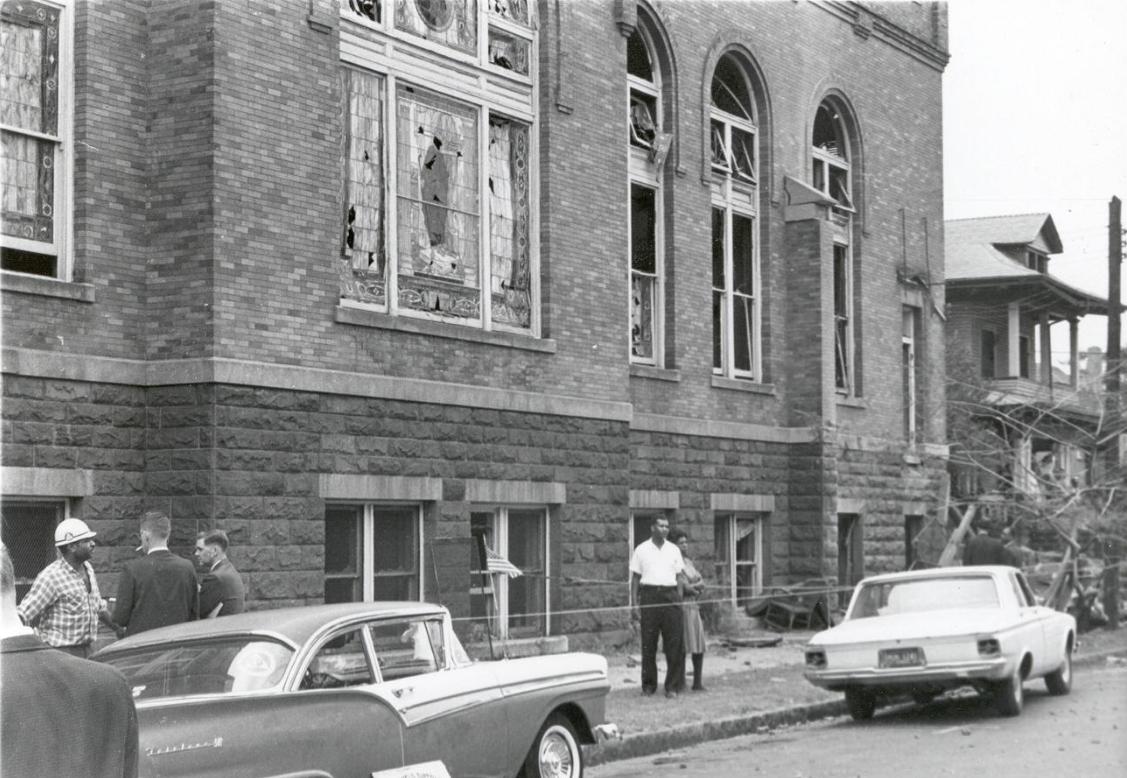
BIRMINGHAM, Ala. — It was a quiet Sunday morning in Birmingham—around 10:24 on September 15, 1963—when a bomb made from dynamite exploded in the back stairwell of the downtown Sixteenth Street Baptist Church. Minutes before a white man was seen placing a box under the steps of the church.
The blast killed Addie Mae Collins, 14; Carole Robertson, 14; Cynthia Wesley, 14; and Denise McNair, 11 injuring 20 more and left the sister of Addie Mae Collins, 12-year-old Sarah Collins Rudolph, suffering from not only the loss of her sister, but her eyesight as well.
The Federal Bureau of Investigation notes in the agency’s history of the event that the bombing was a clear act of racial hatred: the church was a key civil rights meeting place and had been a frequent target of bomb threats.
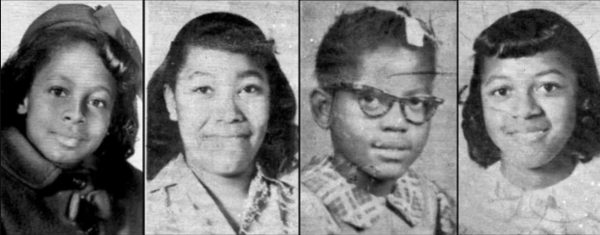
(Photo Credit: Photographic collections of the Library of Congress)
Addressing the American people on Monday, September 16, 1963, President John F. Kennedy said:
“I know I speak on behalf of all Americans in expressing a deep sense of outrage and grief over the killing of the children yesterday in Birmingham, Alabama. It is regrettable that public disparagement of law and order has encouraged violence which has fallen on the innocent. If these cruel and tragic events can only awaken that city and State–if they can only awaken this entire Nation–to a realization of the folly of racial injustice and hatred and violence, then it is not too late for all concerned to unite in steps toward peaceful progress before more lives are lost.
The Negro leaders of Birmingham who are counseling restraint instead of violence are bravely serving their ideals in their most difficult task–for the principles of peaceful self-control are least appealing when most needed.
Assistant Attorney General Burke Marshall has returned to Birmingham to be of assistance to community leaders and law enforcement officials–and bomb specialists of the Federal Bureau of Investigation are there to lend every assistance in the detection of those responsible for yesterday’s crime. This Nation is committed to a course of domestic justice and tranquility–and I call upon every citizen, white and Negro, North and South, to put passions and prejudices aside and to join in this effort.”
The FBI’s account of the aftermath and investigation
At 10:00 p.m. that night, Assistant Director Al Rosen assured Assistant Attorney General Katzenbach that “the Bureau considered this a most heinous offense…[and]…we had entered the investigation with no holds barred.”
And we backed that promise up. Dozens of FBI agents worked the case throughout September and October and into the new year—as many as 36 at one point. One internal memo noted that:
“…we have practically torn Birmingham apart and have interviewed thousands of persons. We have seriously disrupted Klan activities by our pressure and interviews so that these organizations have lost members and support. …We have made extensive use of the polygraph, surveillances, microphone surveillances and technical surveillances…”
By 1965, we had serious suspects—namely, Robert E. Chambliss, Bobby Frank Cherry, Herman Frank Cash, and Thomas E. Blanton, Jr., all KKK members—but witnesses were reluctant to talk and physical evidence was lacking. Also, at that time, information from our surveillances was not admissible in court. As a result, no federal charges were filed in the ‘60s.
It has been claimed that Director Hoover held back evidence from prosecutors in the ‘60s or even tried to block prosecution. But it’s simply not true. His concern was to prevent leaks, not to stifle justice. In one memo concerning a Justice Department prosecutor seeking information, he wrote, “Haven’t these reports already been furnished to the Dept.?” In 1966, Hoover overruled his staff and made transcripts of wiretaps available to Justice. And he couldn’t have blocked the prosecution and didn’t—he simply didn’t think the evidence was there to convict.
For its part, the FBI noted that in the end, justice was served.
Chambliss received life in prison in 1977 following a case led by Alabama Attorney General Robert Baxley. And eventually the fear, prejudice, and reticence that kept witnesses from coming forward began to subside. We re-opened our case in the mid-1990s, and Blanton and Cherry were indicted in May 2000. Both were convicted at trial and sentenced to life in prison. The fourth man, Herman Frank Cash, had died in 1994.
Marking the 16th Street Baptist Church bombing, 60 years later
Birmingham NBC News affiliate WVTM-TV 13 reported that the 16th Street Baptist Church rang its bells in honor of bombing victims 60 years later at 10:22 a.m. and read the victims’ names out loud in remembrance.
U.S. Supreme Court Associate Justice Ketanji Brown Jackson was the keynote speaker Friday during the commemoration service at 16th Street Baptist Church 60 years after the bombing that killed four girls.
In her remarks, Jackson, the first Black woman to serve on the U.S. Supreme Court, standing at the pulpit in the historic church told those gathered for the commemoration services,
“Today we remember the toll that was paid to secure the blessings of liberty for African Americans and we grieve those four children who were senselessly taken from this earth and their families robbed of their potential,” Jackson said.
”The work of our time is maintaining that hard-won freedom and to that we are going to need the truth, the whole truth about our past,” the Justice said noting that while the American nation should celebrate the advancements that have been made since 1963, there is still work to do.
Jackson said she knows that atrocities “like the one we are memorializing today are difficult to remember and relive” but said it is also “dangerous to forget them.”
“If we are going to continue to move forward as a nation, we cannot allow concerns about discomfort to displace knowledge, truth or history. It is certainly the case that parts of this country’s story can be hard to think about,” she said adding, “Yes, our past is filled with too much violence, too much hatred, too much prejudice, but can we really say that we are not confronting those same evils now? We have to own even the darkest parts of our past, understand them and vow never to repeat them.”
Related:
Birmingham church bombing survivor speaks out 60 years later:
History
‘Fagots Stay Out:’ Protest at Barney’s Beanery 53 years ago today
Rocco interviews Morris Kight, founder of the California chapter of the Gay Liberation Front and a young Rev. Troy Perry
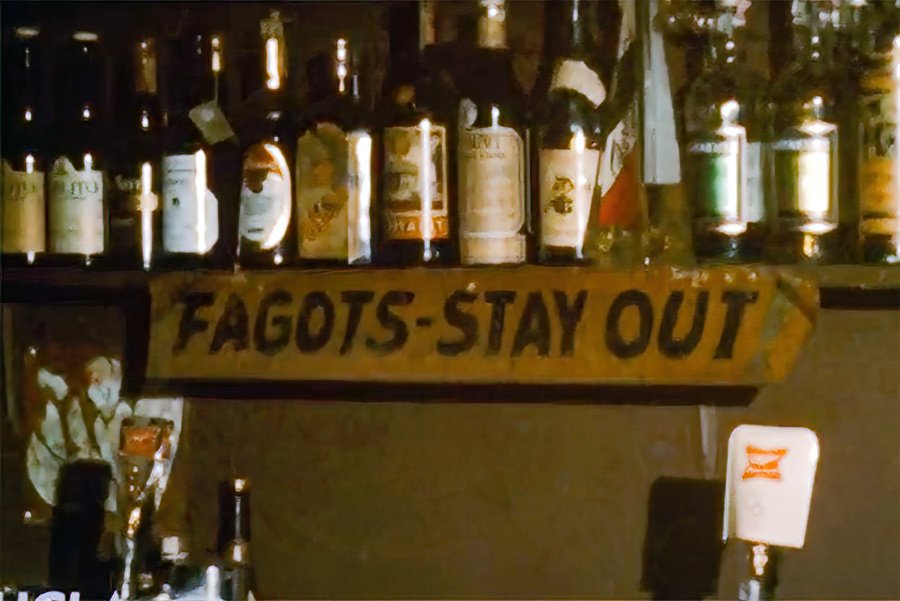

By Paulo Murillo | WEST HOLLYWOOD – The Academy Awards Museum recently featured three short films by trailblazing Los Angeles-based filmmaker and gay rights advocate Pat Rocco (1934–2018) last week, courtesy of Outfest UCLA Legacy Project at the UCLA Film & Television Archive.
Films featured were “Sign of Protest” (1970), “Meat Market Arrest” (1970), and “We Were There” (1976).
The short film “Sign of Protest” documents a February 7, 1970, gay liberation march outside Barney’s Beanery in West Hollywood, protesting a famous sign that read “Fagots [sic]–stay out” which hung proudly over the bar.
Rocco plays the role of neutral reporter on the scene in this activist interpretation of a newsfilm, interviewing the bar’s owners and patrons, as well as the protestors, and allowing their comments to speak for themselves.
Rocco is shown speaking with the daughter of the bar’s owner, who states nonchalantly that the sign has been up since 1959 and was originally accompanied by many more (since removed). She further states that the sign is part of the restaurant’s history and will not come down unless Barney’s is legally mandated to remove it.
Rocco then goes over to the sign posted above the bar and interviews customers about their opinion of it, which is largely positive.
Next, Rocco joins the 50 protesters outside and interviews Morris Kight, founder of the California chapter of the Gay Liberation Front, the organization that spearheaded the picket and a young Rev. Troy Perry, founder of the gay-affirming Metropolitan Community Church, who reiterates many of the comments heard from other protesters that the sign is offensive and should be taken down as a civil rights violation.
He also mentions a June 26, 1964, LIFE Magazine article about Barney’s Beanery and the controversial sign where the owner says homosexuals should be shot.
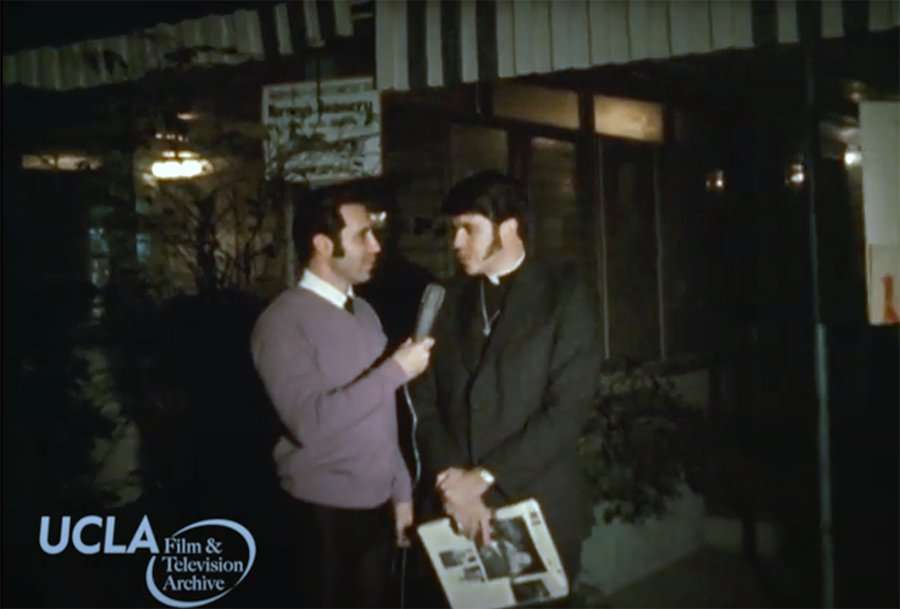
For those who missed on the big screen or wish to revisit it, the short film is available on YouTube, however, view at your discretion due to language some may find offensive.
Trailblazing Los Angeles-based filmmaker and gay rights advocate Pat Rocco (1934–2018) began his moviemaking efforts as a creator of queer male erotica in the late 1960s. When the public’s appetite shifted to hardcore, Rocco pivoted to documenting moments of LGBTQ protest and collective joy in his adopted city, often appearing on camera as an always gracious (and meticulously coiffed) interviewer of his many subjects.
Whether out in the streets capturing a demonstration of Barney’s Beanery in West Hollywood against their defamatory anti-gay signage (Signs of Protest), on the scene of an escalating situation with law enforcement at a gay bar (Meat Market Arrest), or capturing LA’s energetic early Pride parades (We Were There), Rocco’s films always culminate in moments of hope and a spirit of liberation that feel akin to Varda’s own joyful yet always inquisitive Weltanschauung.
**************************************************************************************
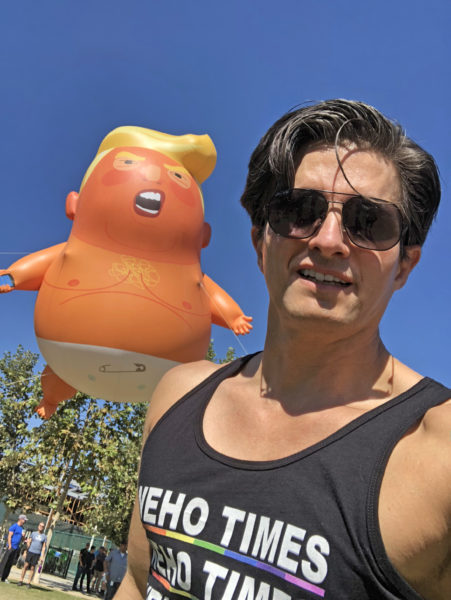
Paulo Murillo is Editor in Chief and Publisher of WEHO TIMES. He brings over 20 years of experience as a columnist, reporter, and photo journalist.
******************************
The preceding article was previously published by WeHo Times and is republished with permission.
History
Marking slavery’s end, a historic event now marks a Federal holiday
“The people of Texas are informed that, in accordance with a proclamation from the Executive of the United States, all slaves are free”
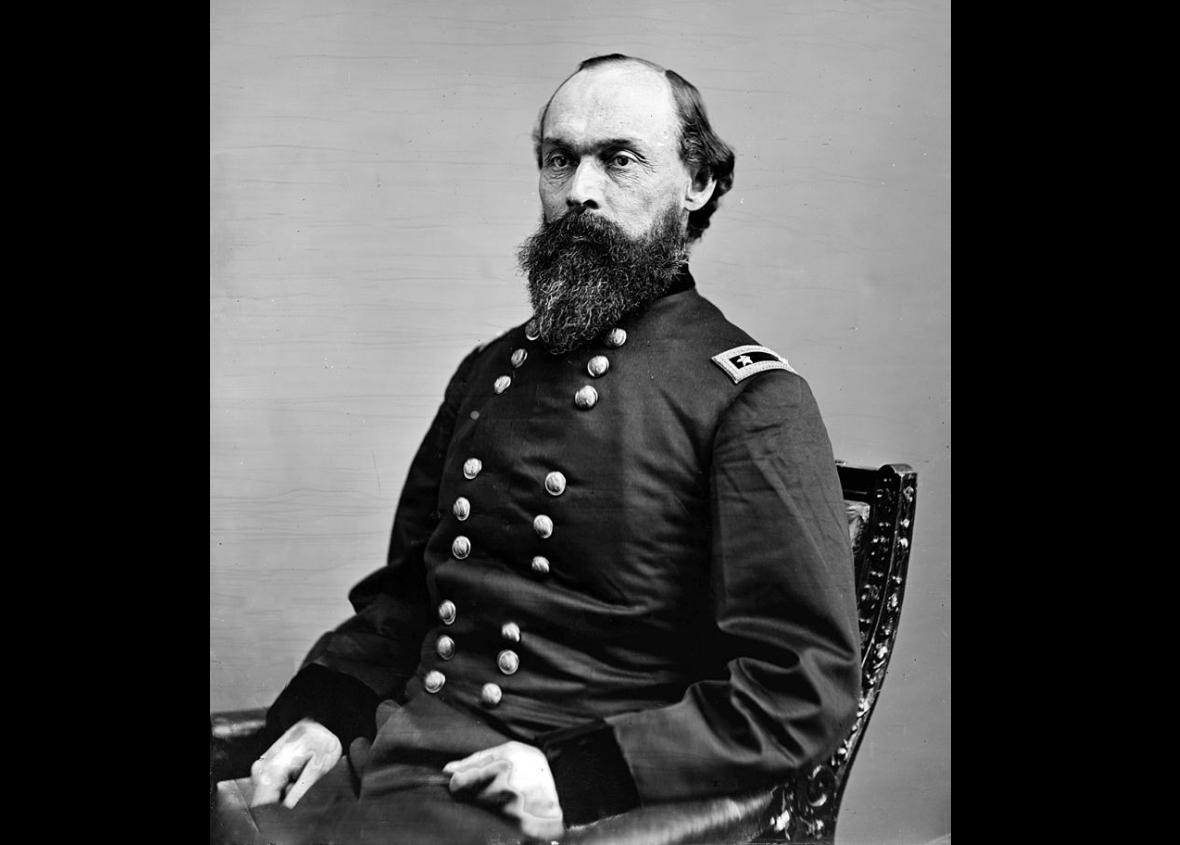
GALVESTON, Tx. – In the early summer of 1865, on a clear crisp June morning, the lead elements of the Federal Army of blue-coated soldiers of the 13th Army Corps occupied the island city of Galveston, Texas on Monday the 19th.
Led by Union Army Major General Gordon Granger, who had recently taken command of the Department of Texas, the 13th Corps was tasked with enforcement of the emancipation of slaves in the former Confederate state.
The bloody civil war had ended officially with the surrender of the Army of Northern Virginia commanded by Robert E. Lee to Commander of Union forces, Lieutenant General Ulysses S. Grant, at Appomattox Courthouse, Virginia on April 9, 1865.
The warfare between the last elements of the Confederate and Union troops however, dragged on for another month or so culminating in the Battle of Palmito Ranch, which was fought on May 12 and 13, 1865. The fighting occurred on the banks of the Rio Grande east of Brownsville, Texas on the Texas-Mexico border some 400 miles Southwest of Galveston.
It took approximately another two weeks for Confederate Lieutenant General Simon B. Buckner to surrender his command of the Trans-Mississippi Department (which included Texas) to Union Major General Peter J. Osterhaus on May 26, 1865.
General Granger was then tasked with implementing the order to free enslaved African Americans.
Once Granger’s Federals had taken control of the port city, he and his command staff headed to Union Army Headquarters located at the Osterman Building, once located Strand Street and 22nd Street.
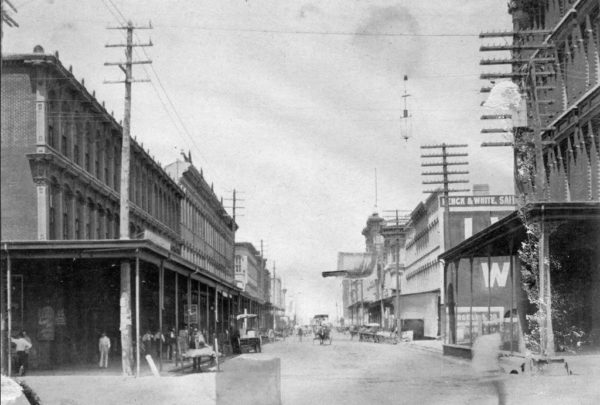
It was there that General Order No. 3 was first publicly read out loud to a gathering of now newly freed Black Americans and other citizens of the city.
“The people of Texas are informed that, in accordance with a proclamation from the Executive of the United States, all slaves are free. This involves an absolute equality of personal rights and rights of property between former masters and slaves, and the connection heretofore existing between them becomes that between employer and hired labor. The freedmen are advised to remain quietly at their present homes and work for wages. They are informed that they will not be allowed to collect at military posts and that they will not be supported in idleness either there or elsewhere.”
Sadly it would take nearly two years before all of the enslaved African Americans would actually be freed in Texas by white plantation owners and others who simply didn’t tell them or defied Federal authorities.
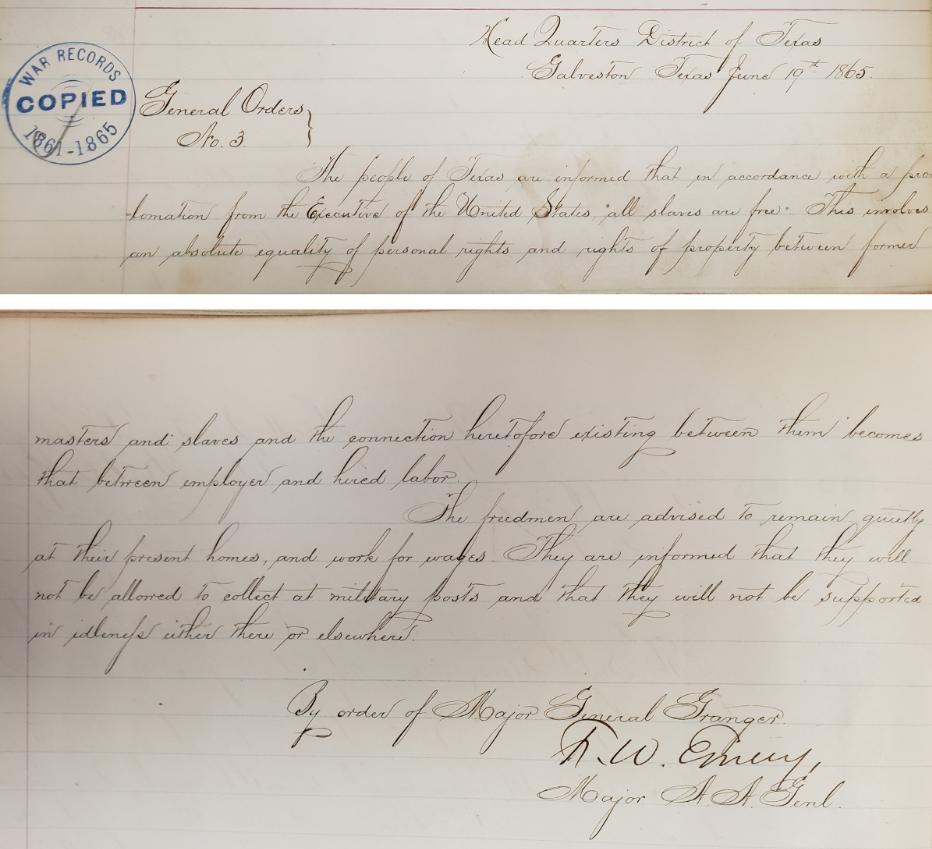
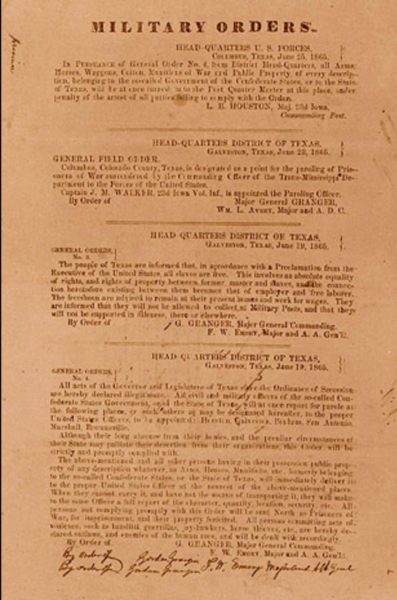
In 2014, the Texas Historical Commission placed a subject marker at the corner of 22nd and Strand, near the location of the Osterman Building, where General Granger and his men first read General Orders, No. 3.
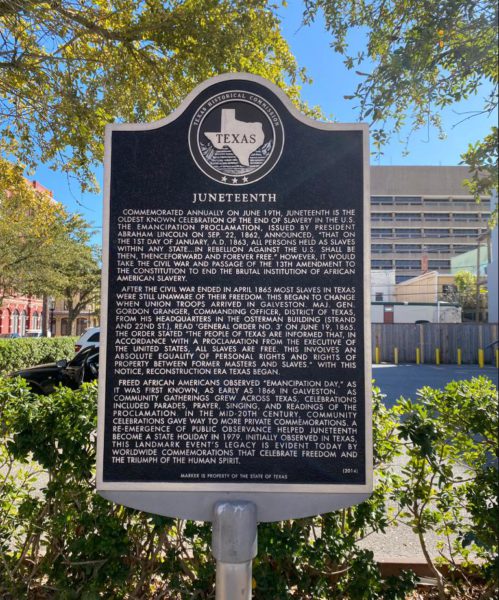
While many Black Americans across the former Confederate States would celebrate their freedom granted by The Emancipation Proclamation, issued by President Abraham Lincoln on Sep. 22, 1862 during the height of the war, in annual celebrations still others yet would annually mark the date of passage of the 13th Amendment to the U.S. Constitution by Congress on January 31, 1865, which abolished slavery in the United States.
Yet on Galveston Island, the tradition of marking their first learning of The Emancipation Proclamation, issued by President Lincoln with General Granger’s General Orders, No. 3, was the benchmark for ongoing annual celebrations and as the years went by as the Black Americans from the Lone Star state migrated ever Northward, it would be that seminal moment that ultimately would lead to the creation of a federal holiday and recognition some 156 years later.
One observer also wryly pointed out that the June anniversary was seasonally tied to better weather than the other two dates and more conducive to celebrations and large gatherings, hence its popularity in being established as the federal holiday.
Information and photographs provided by the National Archives, the City Of Galveston, Galveston Historical Foundation, the Library of Congress, and State of Texas, Texas Historical Commission.
History
50 years ago Atlanta’s nascent gay rights movement marched
“It was mostly about feeling good,” said Phil Lambert. “That we’re not a bunch of sick people. That we’re not the problem.”
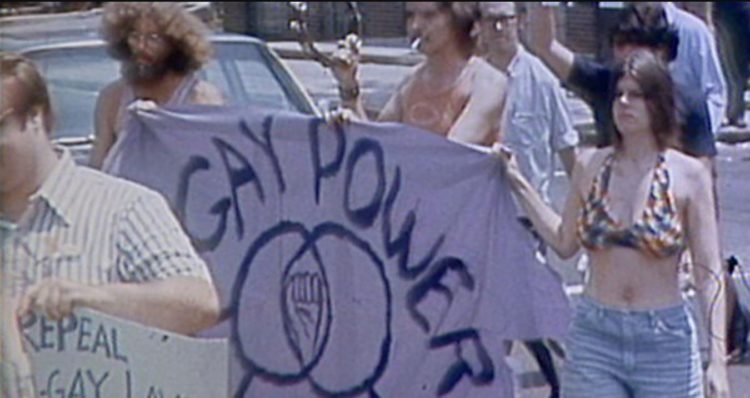
ATLANTA, Ga. – This Sunday, exactly fifty years ago to the day on a bright Sunday morning, about a hundred brave gay and lesbian Atlantans from the Georgia Gay Liberation Front, unfurled a lavender colored banner made from a bedsheet with the intertwined symbols representing male + male, female + female with the a raised fist of defiance and the words ‘Gay Power’ emblazoned on it and they marched.
The group inched its way up Peachtree Street to a soundtrack of chants, kazoos and a tambourine.
Mindful that stepping off the sidewalks could get them arrested — the city of Atlanta had turned down their request for a permit and the police were closely watching for jay-walkers — the marchers stopped at every corner until they were given the crossing signal, the Atlanta Journal-Constitution reported.
Prior to the coronavirus pandemic, the average estimated crowds in attendance at Atlanta Pride is upwards of 300,000 plus. But at the time the Journal-Constitution noted, even in the city that had just birthed the civil rights movement and was home to Dr. Martin Luther King Jr., LGBTQ rights was considered a radical issue that the Georgian liberal political establishment, including many Atlanta progressives, wanted to stay away from. At that time, gay sex was still illegal under state law, and the American Psychiatric Association characterized homosexuality as a mental illness.
For those GAGLF Atlantans who participated in that first pride march on June 27, 1971, the event was a turning point, a moment when, for the first time, they could publicly celebrate a part of themselves that society had long demanded they keep hidden.
“It was mostly about feeling good,” said Phil Lambert, a Vietnam veteran who was in attendance. “That we’re not a bunch of sick people. That we’re not the problem.”
Read the entire fascinating story: 50 years ago, Atlanta’s gay rights push took to street for first time
History
LGBTQ rainbow flag was born in San Francisco, but its history is disputed
On that day in June 1978, it felt as if the rainbow had always been a symbol for the LGBTQ community, it just hadn’t revealed itself yet
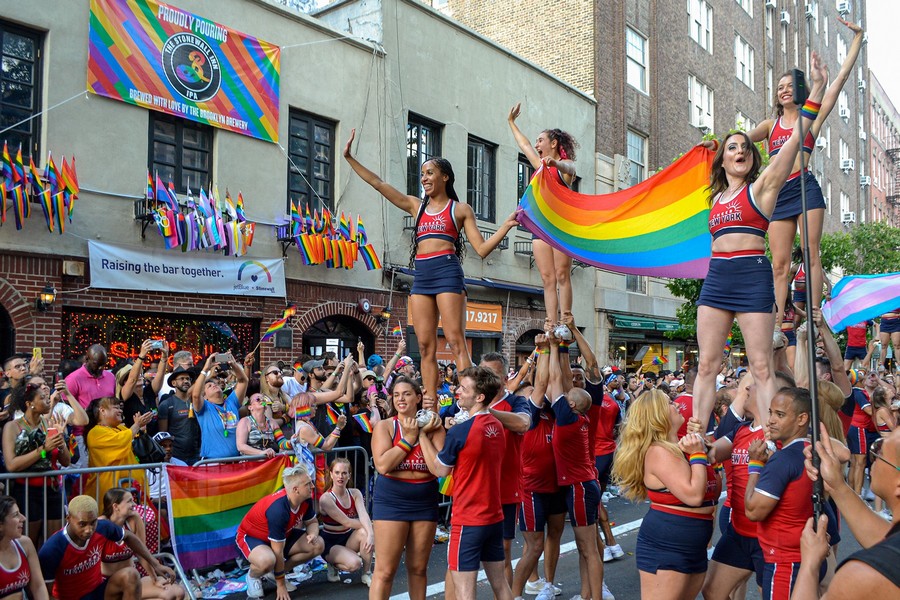
By August Bernadicou (with additional text and research by Chris Coats) | NEW YORK – Many enduring symbols that establish an instant understanding and define a diverse community are intrinsically linked with controversy, confusion, and ill-informed backstories dictated by vested interests and those who told the story loudest. The LGBTQ rainbow flag is no different.
While it was the work of many, the people who deserve credit the most have been minimized if not erased. Gilbert Baker, the self-titled “Creator,” screamed the story and now has a powerful estate behind his legacy. Before his death in 2017, Baker established himself as the complete authority on the LGBTQ rainbow flag. It was his story which he lived and became.
While there are disputed accounts on the flag’s origins, one thing that is not disputed is that the LGBTQ rainbow flag was born in San Francisco and made for the Gay Freedom Day Parade on June 25, 1978.
For all of human history, rainbows have mystified and inspired. A greeting of light and serenity after the darkness and chaos of a storm. They have symbolized hope, peace, and the mysteries of existence. For a moment, we can see the invisible structure, the “body” of light, made visible. A secret revealed, then hidden again.
Though it may seem like a modern phenomenon, rainbow flags have waved throughout history. Their origin can be traced to at least the 15th Century. The German theologian, Thomas Müntzer, used a rainbow flag for his reformist preachings. In the 18th Century, the English-American revolutionary and author, Thomas Paine, advocated adopting the rainbow flag as a universal symbol for identifying neutral ships at sea.
Rainbow flags were flown by Buddhists in Sri Lanka in the late 19th Century as a unifying emblem of their faith. They also represent the Peruvian city of Cusco, are flown by Indians on January 31st to commemorate the passing of the spiritual leader Meher Baba, and since 1961, have represented members of international peace movements.
Now, the rainbow flag has become the symbol for the LGBTQ community, a community of different colors, backgrounds, and orientations united together, bringing light and joy to the world. A forever symbol of where they started, where they have come, and where they need to go. When many LGBTQ people see a rainbow flag flowing in the wind, they know they are safe and free.
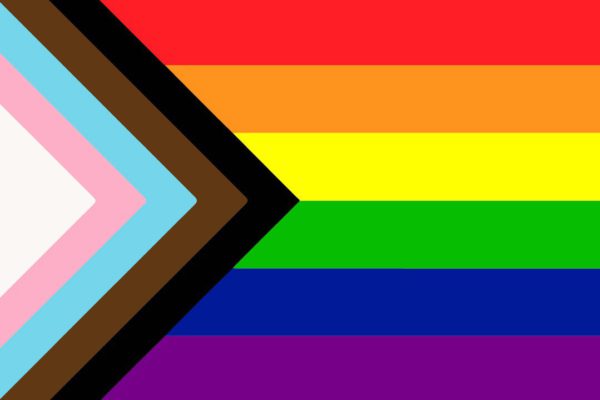
While the upper class and tech interests rule the city now, in the 1960s and 70s, San Francisco was a wonderland for low and no-income artists. The counterculture’s mecca. By the mid-1970s, the Haight-Ashbury neighborhood that had once been a psychedelic playground of hippie art, culture, and music had fallen into disarray. Hard, dangerous drugs like heroin had replaced mind-expanding psychedelics. Young queers and artists needed a new home, and they found it in the Castro.
Lee Mentley (1948-2020) arrived in San Francisco in 1972 and quickly fell in with the oddball artist and performers in the Castro neighborhood, donning flamboyant, gender-fucked clothes, performing avant-garde theater, and creating their own clubhouses. He was on the Pride Planning Committee in 1978 and ran the Top Floor Gallery on the top floor of 330 Grove, which served as an early Gay Center in San Francisco.
Lynn Segerblom (Faerie Argyle Rainbow) was originally from the North Shore of Hawaii and moved to San Francisco where she attended art school at the Academy of Art. Her life changed when she found a new passion in tie-dye and rainbows in the early 1970s. Entrenched in the free-loving technicolor world of San Francisco, in 1976, Lynn legally changed her name to Faerie Argyle Rainbow. She joined the Angels of Light, a “free” performance art troupe where the members had to return to an alternative, hippie lifestyle and deny credit for their work.
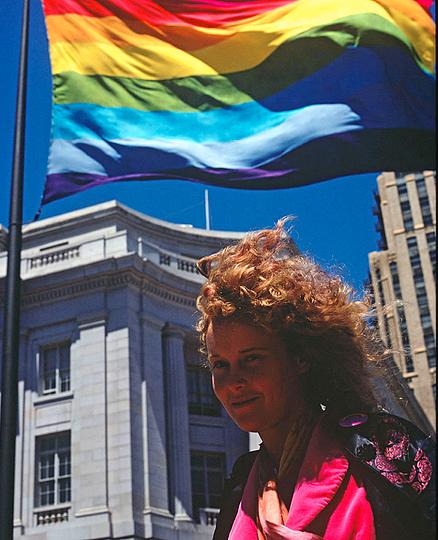
Shortly after the original rainbow flags were flown for the last time, both Lynn and Lee moved out of San Francisco. Lee moved to Hawaii and Lynn moved to Japan. When they returned, they were shocked to see how their contribution to history was becoming a universal symbol. They remain passionate about defending their legacies and giving a voice to the mute.
——–
LEE MENTLEY: “One day in 1978, Lynn came to 330 Grove with a couple of her friends, James McNamara and Robert Guttman, and said we should make rainbow flags for Gay Day to brighten up San Francisco City Hall and Civic Center because it’s all gray and cold in June. We thought that it sounded like a great idea.”
To get over the first hurdle, money, the young artists went to Harvey Milk, the first openly gay elected official in the history of San Francisco, California, for help.
LEE: “There was no actual funding for it. We contacted Harvey Milk and another supervisor, and they asked the city if we could get a little funding. They found some leftover funds from the previous year’s hotel tax, and we got $1,000.”
LYNN SEGERBLOM: “I remember having a meeting where I presented the idea of making rainbow flags. I had some sketches. At that meeting, there was just a handful of us there, and I remember, and even my friend assured me, that Gilbert Baker was not at that meeting. I don’t know where he was, I didn’t keep track of him, but he was not at the meeting where I suggested rainbow flags. We decided, yes, rainbow flags sounded great.”
The committee approved the rainbow imagery and made the decision to make two massive 40’ x 60’ foot rainbow flags to be flown at the Civic Center along with 18 smaller rainbow flags designed by different, local artists, to line the reflecting pool putting rainbows into the grey sky.
For the two large flags, one would be an eight-color rainbow starting with pink and including turquoise and indigo in place of blue, and the other a re-envisioning of the American flag with rainbow stripes which became known as Faerie’s flag.
——
Gilbert Baker’s name on his memoir, Rainbow Warrior, it says “CREATOR OF THE RAINBOW FLAG,” leaving little debate that Gilbert claimed full ownership for the concept and design of the legendary symbol. He never denied Lynn or James MacNamara’s involvement in the flags’ construction and speaks briefly and fondly of them and their talents in that same book.
LEE: “We didn’t need one person saving our ass, and it certainly wouldn’t have been Gilbert Baker. He was no Betsy Ross. He was a very good promoter, and I give him all the credit in the world for making the rainbow flag go international. He did a great service, and he was a very talented, creative man, but he could never have done all of the work by himself; no one could have.
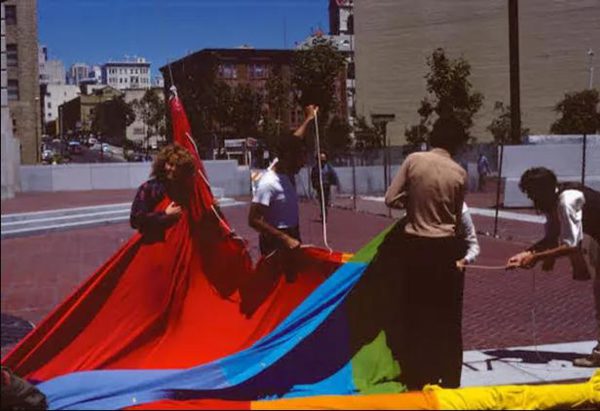
We never considered ownership. There was never this big ownership debate until Gilbert started it. Because AIDS hit us so fast after this, most of our leadership either went into HIV activism or died.”
LYNN: “The story is that a white gay man did all of this by himself, but, in fact, that is not true at all. He just promoted it. For that, though, he should be given great love.”
————
Making the two original rainbow flags was no easy feat. With a limited budget and limited resources, the group had to improvise and figure it out as they went along. While Lynn had dabbled in flags before, a project of this scope and importance was far beyond her comfort zone.
LEE: “The community donated the sewing machines we used. We asked people at the Center if anyone would like to volunteer. All sorts of people from all over the country helped us with the flags, over 100 people, which, to me, is an amazing story. That’s where it came from. It came from regular artists who wanted to have fun and make something pretty for gay people.”
LYNN: “The Rainbows Flags were hand-dyed cotton and eight colors. I made two different types. The one with just the stripes and then the American flag one, which I designed myself. There was a group of us that made them, James McNamara, Gilbert Baker, and myself. Originally they were my designs. I was a dyer by trade, and I had a dying studio at the Gay Community Center at 330 Grove Street.”
LEE: “People would come and help as long as they could. Then, somebody else would come and help as long as they could. We opened up the second floor of 330 Grove to people who came to be in the Parade and march. People came in and made posters, banners and did art stuff.”
LYNN: “We made the flags on the roof because there was a drain up there. There was a wooden ladder that led up to the roof. The hot water had to be carried up to the roof because we didn’t have hot water up there. We heated it up on the stove in pots. We put the hot water in trash cans on the roof.”
LEE: “We had trash cans and two by fours, and we had to keep agitating the fabrics in the dye. Since they were in hot water, they had to be poked and agitated for hours.”
LYNN: “We had to constantly move the fabric in the dye, so the dye penetrated the fibers that weren’t clamped tight. We had to make sure there would be blue, and it wouldn’t just be white on white or white with a very murky, pale blue.
After they were washed and dyed, they went through the washer and dryer. Then, we ironed them. If the fabric stays out too long, once you take it out of the water, if it sits on itself even for just a few minutes, it starts to make shapes.”
—-
LEE: “Lynn’s flag, the new American flag, was a similar rainbow, but it had stars in the corner. I have photographs of that flag flying at gay events in San Francisco at City Hall and Oakland.”
LYNN: “I always liked the American flag. I thought, oh, wouldn’t that be nice? I knew with some luck I could make it.”

LEE: “I thought the one with the stars was more interesting because it symbolized a new flag for the United States.”
LYNN: “For my American flag, I decided to flip the order of the colors, so pink was at the bottom and purple was at the top in an eight-color spectrum. That was intentional. I wanted them to be different.
I made the stars with wood blocks and clamps. I got the white fabric and washed it, and folded it a different way. When I was making it, it looked like a big sandwich. The bread would be the woodblocks, and the fabric was in between. We immersed the whole flag in dye and swished it around. I wasn’t sure if it would come out right because it was the first time I did that fold. I was lucky. It worked.
I sewed lamé stars into one stripe with leftover stars from my Angels of Light costumes. On one side of the blue stripe, there was a star with silver lamé, and on the other side, there was a star with gold lamé.
I got all these ideas because I worked with these mediums on a daily basis: paint, dye, fabric, and glitter.”
—
LEE: “We worked for weeks dying fabric, shrinking fabric, and sewing fabric.”
LYNN: “We worked on them for seven weeks. I was worried that we weren’t going to finish on time. We worked hard and long hours. Towards the end, we decided we didn’t have time to go to the laundromat, so we started rinsing them on the roof and wringing them dry. We also ran out of quarters. We draped them off of the Top Floor Gallery’s rafters, and they drip-dried. They looked great. They were beautiful.”
Until that day, the pink triangle, used by the Nazis to label homosexuals in their genocidal campaign, was the most commonly used symbol for the LGBTQ movement, a symbol in solidarity with our fallen ancestors. But the triangle came from a place of trauma, it was a reminder of the storm while the rainbow was the hope that came after. The promise of brighter days ahead.
On that day in June 1978, it felt as if the rainbow had always been a symbol for the LGBTQ community, it just hadn’t revealed itself yet.
LEE: “We went out, flew the flags, and blew everybody’s fucking minds. People were blown away. The flags were so beautiful. They were waving warriors. The biggest ones were 40’ by 60’ feet. The Parade marched through the flags to get to Civic Center. We instantly proclaimed that this was our symbol. It wasn’t planned. It was organic.”
LYNN: “It was just what I wanted: a touch of magic, a touch of glitter, and a little bit of Angels of Light.”
LEE: “We weren’t creating this huge symbol. We were decorating Civic Center. We weren’t thinking of marketing our entire futures. It was an art project.”
LYNN: “We looked at the rainbow flags as a work of art, and we wanted them to be beautiful and unique. After the Gay Parade, the flags were a big hit. People loved them. Everybody loved them.”
—-
In the pre-technology world, people and property could just disappear. There were no surveillance cameras. Lynn didn’t even have a phone.
Even though no one could have known the flag would become an eternal symbol for a worldwide community, it was clear even then that they were a piece of history to be coveted.
In his memoir, Baker hypothesizes that the Rainbow American flag was stolen shortly after it was hung up on the front of the Gay Community Center for Gay Freedom Day in 1979. He suggests it might have been a construction crew working on the new symphony across the street and in a homophobic act, stole the flag and buried it in cement.
LEE: “Later in 1979 or 1980, you can find it somewhere in the minutes for a Pride Foundation meeting, Gilbert came to us and asked to borrow the two large flags, and we agreed. We never saw them again.”
LYNN: “I went to work one day at 330 Grove, and Gilbert came in and said that the two 40’ by 60’ flags had been stolen.”
Images published in the San Francisco Chronicle, videos of the march, and other widely distributed photographs only add to the mystery. They show both the classic rainbow flag of eight stripes and the American revision flying at the Civic Center on June 24, 1979 and not at the Gay Community Center.
As for the original eight-stripe flag, there are even fewer answers. In his memoir, Baker says that while they were taking down the flags from Civic Center, he was hit on the head on knocked out. “When I came to on the muddy ground,” he says “I saw people all around me hitting each other and screaming obscenities. They were fighting over the rainbow flags, pulling on them like a game of tug-of-war, tearing them.”
LYNN: “It would have taken more than one person to carry the flags. It took three people to carry one folded-up flag for the Parade, and we needed a van. They weighed a lot, and 330 Grove did not have an elevator. Whoever stole them had help—one person could not do it on their own.”
—-
LYNN: “Before the rainbow flag missing, Gilbert came to one of my workshops. He wanted to watch me dying fabric all day and see how I did everything.
I was like, oh yeah, I’ll show you, come in.
I said, here, put some gloves on and do it with me.
He was like, oh, no, no, I don’t want to get my hands dirty.
He was only trying to figure out how I did the dying.”
—-
LEE: “Gilbert went to these places like MoMa and told them these outrageous stories about how he made the rainbow flag all by himself. He said this about the flag he donated. When you look at it, you can tell that it was bought at a craft fair. It flat out wasn’t one of our flags. It was polyester.”
LYNN: “It was polyester, it wasn’t the same size, and it wasn’t hand-dyed. My flags were different. The rainbow flag at MoMa was a beautiful flag inside a frame, but it wasn’t an original, not from 1978, not even a piece from 1978. I was hoping, oh, my God, maybe this is a piece of it.”
LEE: “It wasn’t even the original colors. MoMa said they were original flags, but they weren’t. It was a commercially produced rainbow flag with a primary color rainbow. The plaque cited Gilbert donating it as an original flag.”
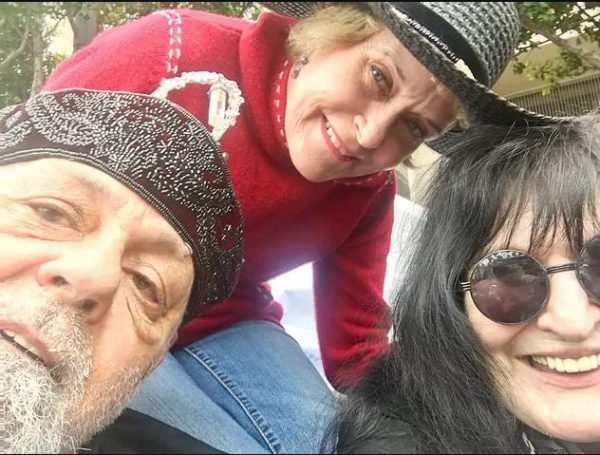
—-
LYNN: “I read online that Gilbert Baker said he named me “Faerie Argyle Rainbow,” a complete lie. Bethany the Princess of Argyle named me. I chose the name Rainbow because I was known as a rainbow artist.”
LEE: “Even Lynn’s driver’s license said her name was “Faerie Argyle Rainbow.””
LYNN: “In 1976, I filled out a form at the DMV, and my name became Faerie Argyle Rainbow. Back then, they didn’t ask you for a birth certificate. The employee just said, “This is your name now,” and gave me a driver’s license that said Faerie Argyle Rainbow.
It all sounds crazy now, but back then, it wasn’t.”
—–
LEE: “I had my arguments and fights with Gilbert Baker because he claims he came up with the rainbow flag. If you go through all of his different interviews, you see that his story changes over and over and over again. He even said Harvey Milk came to him and asked him to create a symbol for the movement. No—I read that, and no such thing happened.”
LYNN: “Just look at his interviews. His takes on what the colors in the rainbow flag mean are all in his head. The rainbow represents everyone, no matter what gender or race you are; that’s how I looked at it. Rainbows are in nature and beautiful. People love them, and I love them. I knew they would be great color healing.
Gilbert assigning meaning to each color is ridiculous. I think anyone could make up what each color means. If I wanted to, I could do the same. It wasn’t what I was thinking. I was thinking that rainbows encompass everybody, the whole group, unity.”
LEE: “I have tried to convince people that the rainbow flags were made with tax-payer dollars. We made them as a non-profit.
Not even Gilbert owns them. I have always thought that anyone who sells anything rainbow should give a portion of the profits to homeless gay youth. We need to take care of our own kind because no one does. The whole concept of taking care of gay people has disappeared.”
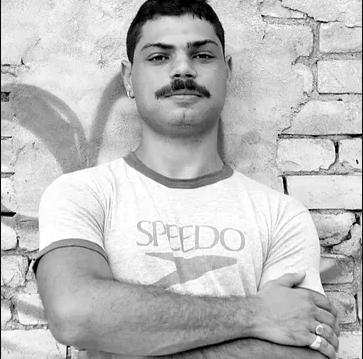
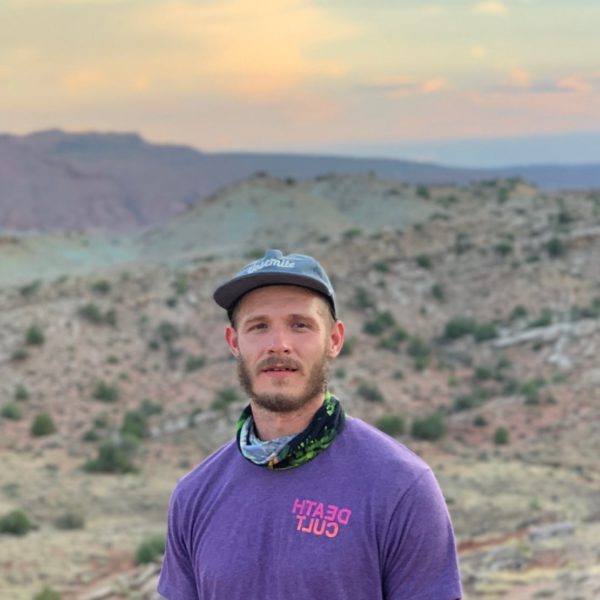
August Bernadicou is a 27-year-old gay historian and the President of the LGBTQ History Project Inc. Chris Coats is an editor and producer.
Together, they produce the QueerCore Podcast and will shortly be releasing an episode that is the definitive story on the rainbow flag featuring Lee Mentley, Lynn Segerblom, and Adrian Brooks.
August Bernadicou is presenting a Pride event in NYC this year that all folks are cordially invited to attend- its virtual;
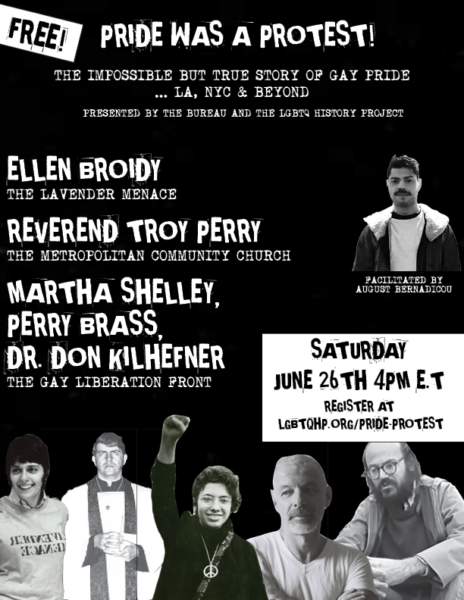
Here is the link for the event: https://www.lgbtqhp.org/pride-protest
-
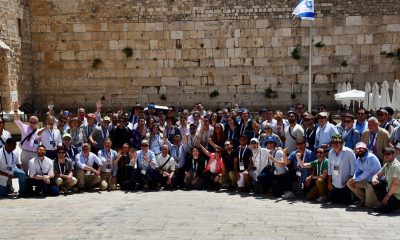
 Viewpoint5 days ago
Viewpoint5 days agoI’m a queer Iranian Jew. Why I stand with Israel during this conflict
-
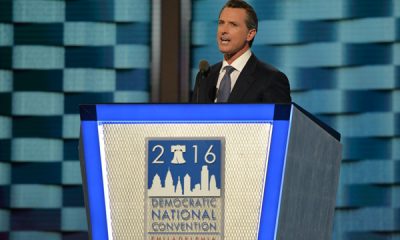
 Congress4 days ago
Congress4 days agoWhite House finds Calif. violated Title IX by allowing trans athletes in school sports
-
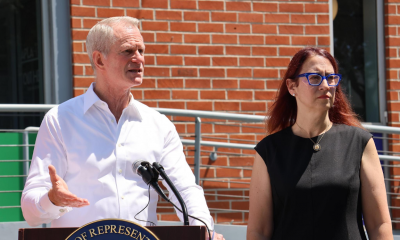
 Breaking News11 hours ago
Breaking News11 hours agoMajor victory for LGBTQ funding in LA County
-
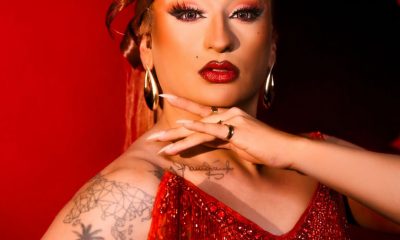
 a&e features3 days ago
a&e features3 days agoLatina Turner comes to Bring It To Brunch
-

 Books2 days ago
Books2 days agoTwo new books on dining out LGBTQ-style
-
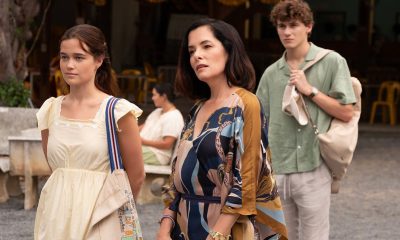
 Television4 days ago
Television4 days ago‘White Lotus,’ ‘Severance,’ ‘Andor’ lead Dorian TV Awards noms
-
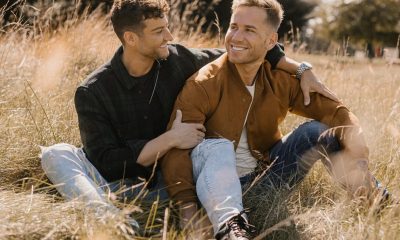
 Features7 hours ago
Features7 hours agoKoaty & Sumner: Finding love in the adult industry
-
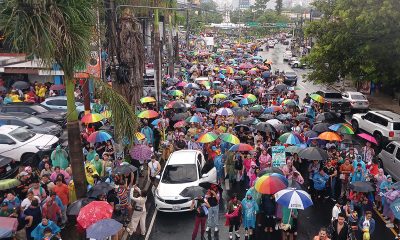
 El Salvador16 hours ago
El Salvador16 hours agoLa marcha LGBTQ+ desafía el silencio en El Salvador

